Best Full-Body Beach Workout (No Equipment Needed) 21 Dec 2023 12:00 AM (last year)
As soon as summer hits, there’s a flood of articles about the perfect bikini body workout, but I can do one better – why not exercise at the beach?
Yep, our favourite summer destination isn’t just for sunbaking and splashing in the waves. The beach is also the perfect place to break a sweat, as sand resistance will upgrade any strength, cardio or endurance workout.
I love exercising outdoors, and I’ve been doing these beach workout circuits for years. Let me tell you, they never get old! They’re challenging, fun, and a natural energy-booster. Best of all, they require zero equipment.
With a great mix of cardio and strength, they’re the ideal summer workout to tone up and work your entire body.
Read on to learn all my beach workout secrets!
10 Benefits of Working Out on the Beach
Wondering why you should take your training session to the beach? Exercising on sand boosts the effectiveness of strength, cardio and endurance workouts.
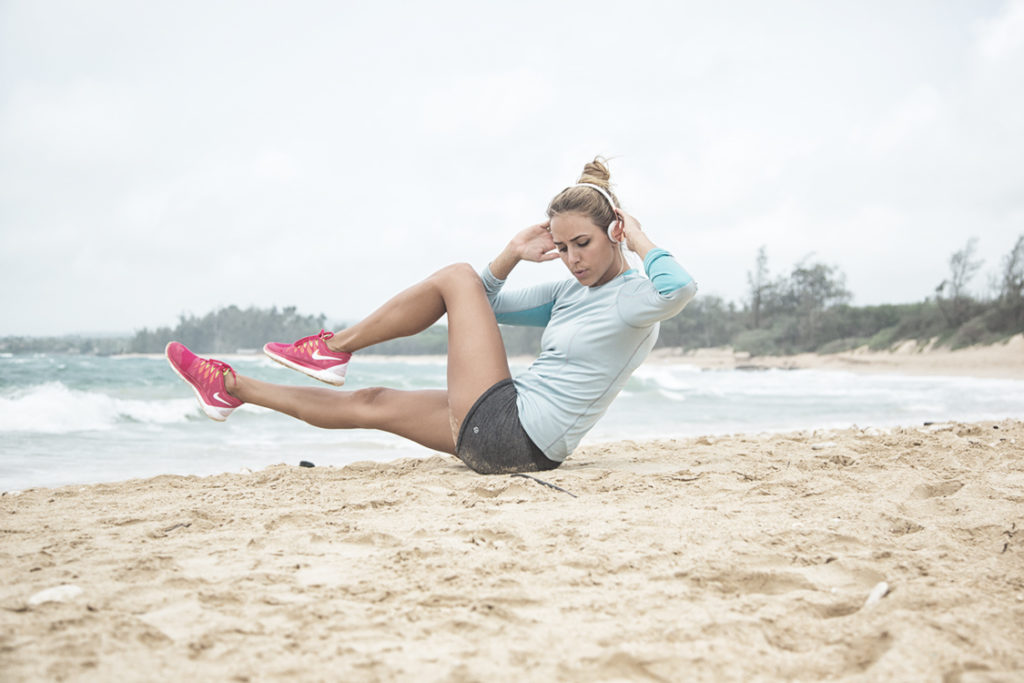
Here are ten reasons to exercise on the beach, according to science:
- Higher energy expenditure & calorie burn: Sand provides more resistance than other surfaces, so the same exercises take more effort. As you expend more energy, your heart rate increases faster, and you burn more calories. In a 2020 study, diabetes patients who walked on sand lost more weight than the ‘regular walking’ group.
- More toned lower legs: The increased need for stabilisation on sand engages muscles in a deeper range of motion, providing a better leg workout than on solid surfaces. A study of 51 students compared the effects of sand running and road running; results showed sand runners built more calf muscle and performed better on athletic tests.
- Improved functional fitness: Exciting research suggests stabilising during beach running or walking engages different neural and muscular pathways. Exercising on sand has been shown to improve functional ability scores in older adults and stroke and MS patients, with benefits like increased lower body strength, improved balance, and a steadier gait.
- Lower impact on joints: Sand is a shock-absorbent surface, reducing the impact on joints even during high-intensity exercise. For athletes, exercising on the beach can reduce muscle soreness and minimise next-day performance impacts after training. Reduced joint reaction forces can also make training on the beach a lower-impact option for people with arthritis.
- Natural variation in environment: Exercising on softer and drier sand will burn the most energy, while compact wet sand is less strenuous to run on. Add a sloping surface, inclined beach pathways, benches and bike paths, and you have all the ‘equipment’ you need to mix up your workout.
- Mood-boosting surroundings: We know that outdoor exercise is a mood-booster, and the uncluttered ‘blue’ beach environment is even better for mental health than ‘green’ environments. Watching and hearing ocean waves changes the frequency of our brain waves and activates our parasympathetic nervous system, decreasing stress and inducing a near-meditative state.
- Daily dose of Vitamin D: Exercising in the sun means your body will be soaking up some much-needed vitamin D, helping to maintain strong bones and a healthy immune system, among other benefits. Just remember to be sun smart as well!
- Health benefits of ocean air: The fresh ocean breeze is filled with negative air ions, which some studies suggest can improve focus, lower blood pressure, and alleviate symptoms of depression. Plus, if you suffer from hay fever or allergies, you’ll be glad to know that sea air typically has less pollen.
- Increases motivation to exercise: Did you know that people living near the beach tend to exercise more? Studies in Australia, New Zealand and the UK have all determined that coast-dwellers are more physically active. Between swimming, beach workouts, surfing, and coastal walks, there really is something for everyone!
- Free and convenient: If you’re lucky enough to live near the coast, working out on the beach is completely free! No need for expensive gym memberships or equipment, and there are no opening hours to work around, so you can always choose your ideal workout time.
Best Beach Workout Exercises
Before we dive into the circuits, here are my favourite exercises to do on the beach. I’ll break down each exercise with images, giving you all the instructions you need to tackle the circuits below.
Beach Crawl
For this exercise, start on your hands and knees with your arms and feet shoulder-width apart. Then, “crawl” forward by lifting your knees off the ground, with opposite limbs moving together (right arm & left leg, left arm & right leg). Yep, just like a baby crawling! Keep your back straight, hips low, and bum down, engaging your core.
Sprints
Sprinting on the beach is a great high-intensity cardio burst to get your heart rate up and strengthen your leg muscles. Keep your knees high, pump your arms, and focus on pushing through the resistance of the sand. To up the difficulty, try running up and down an incline, whether that’s the dunes or beach access path. Sprinting on drier sand will seriously work your leg muscles and provide a killer cardio workout.

Push-ups
Next up, push-ups! This exercise is all about upper body strength, and the sand provides an extra challenge. As you push up, the sand beneath your hands shifts, forcing your muscles to stabilise and work harder than they would on a stable surface. The result is an intensified workout for your arms, chest, and core. Plus, you get a bit of exfoliation for soft hands – it’s a win-win!

V Sit-ups
Lay down facing the ocean, extending your arms above your head. Engage your core and lift your legs to a 45-degree angle. Maintaining good posture with chin tucked, reach your arms up towards your shins. Hold for 5-10 seconds and slowly release. For a more challenging exercise, keep your legs off the ground.

Lunges
Lunges are great for shaping and toning your legs, even on a flat, stable surface. Now, add in the unstable surface of the sand, and you’ve got yourself an upgraded, full-body workout!
When you perform a lunge on the beach, your core must engage to maintain stability, and your leg muscles work even harder to push up from the soft, shifting sand. Trust me, your glutes will feel the burn!

Side Lunges
Side lunges switch up the direction of your movement to add variety and target different muscle groups. Work your inner thighs and glutes by stepping out to the side instead of forward, keeping your feet parallel and your weight in your heels. Side lunges are even better in the sand – really engage your thighs by keeping that leg straight and dragging sand towards your other foot until in a standing position.

Tricep Dips
Tricep dips are fantastic for shaping and toning those arms, and you don’t need specialised equipment to reap the benefits. Find a bench or ledge on the beach, place your hands shoulder-width apart behind you with fingertips facing forward, and bend your elbows to lower yourself down. Push yourself back up using only your triceps, keeping your back close to the bench/ledge.

Planks
Planks are an absolute must in any full-body workout circuit. Holding a plank is amazing for working your entire core – and doing them on the beach takes it up a notch. The instability of the sand means your core has to work even harder to keep your body stable. Plus, I bet you’ll forget about the burn when you’re gazing out at the ocean view! Hold for 30 seconds to a minute, or as long as you can maintain proper form.

Walking & Jogging
Why is this separate from sprints? As speed increases, energy expenditure on a sandy surface becomes more and more similar to grass, negating some of that extra burn. At slower speeds, the calorie-burning benefits of beach training have the most impact!
Essential Beach Workout Tips
Before you get started, here are a few key points for setting up your workout on the beach:
- Go barefoot if possible: This gives your ankles a workout. If you are prone to ankle issues, though, wear your runners.
- Sunscreen is a must: Slather it on the face from the cheeks down so it doesn’t go into your eyes when you sweat.
- Stay hydrated: Make sure you have a water bottle and towel with you.
- Scope out the area: It’s always good to do a quick walk around the area you will be training. This helps avoid nasty surprises (from broken glass and bluebottles to dog doo-doo).
Full-Body Beach Workout Program
Now, onto the main event – the workout circuits.
There are three circuits in total, focusing on different muscle groups and incorporating both cardio and strength exercises. Details of each exercise (with pictures) are found above, so consult them to see the technique.
Warm Up
Start with a 5-minute power walk up the beach, then a 5-minute jog back to the starting point.
Circuit 1
Mark out a 20-metre distance – use your towel, draw a line in the sand or even use some seaweed.
- Beach Crawl for 20 metres – from one line to the other
- 10 Push-ups
- 10 V Sit-ups
- Sprint back to the beginning
Each time you get to the push-ups and V sit-ups, reduce your reps by one. Continue for 10 rounds until you get down to 1.
Circuit 2
Using the same 20-metre distance.
- Lunge Walk from one end to the other
- 10 Side Lunges
- Sprint back to the beginning
Repeat 5 rounds.
Circuit 3
Find a part of the beach that inclines and mark out 20 metres
- Sprint up the incline
- 20 Tricep Dips
- Jog back to the beginning and hold Plank for 30 seconds
Repeat 5 rounds.
Cool Down
Finish with a 5-minute power walk and a stretch of all the major muscles. Maybe even go for a swim if you are up for it, and the conditions are good!
After a high-intensity workout, it’s important to cool down properly, so don’t rush this step. Take advantage of the beautiful beach surroundings for a meditation break or a slow yoga session. The combination of fresh salty air, waves rolling in the background, and stunning natural surroundings will leave you feeling fabulous!
Key Takeaways
There are loads of great reasons to take your workout to the beach. Not only does the sand provide increased resistance and deeper engagement for your muscle groups, but it’s also a fantastic mood booster.
Any location offering a full-body workout without equipment (or a gym membership) is a win in my books. But there are lots of other ways we can make the most of nature’s gym this summer.
Think back to all the ways you enjoyed the beach as a kid. I bet you were running around like crazy the entire time! So, next time you’re heading out for a beach BBQ, consider how you can get active (instead of sitting around with a beer in hand).
Bring a frisbee, footy or beach cricket set and get the whole family having fun! Even running and jumping in the waves with your little ones is surprisingly good exercise.
If you’re lucky enough to live near the ocean, don’t take it for granted! And if you’re visiting on vacation, try to incorporate some high-energy activities into your relaxation schedule, too.
Let’s get back to really enjoying the great outdoors this summer!
More Home Workout Ideas
Here are a few more gym-free workout plans you’ll love:
- AMRAP Bodyweight Circuit Workout
- Oblique Circuit for Toned Side Abdominals
- High-Intensity Plyometric Workout
The post Best Full-Body Beach Workout (No Equipment Needed) appeared first on Amelia Phillips.
Family Christmas on a Budget: 15 Smart Ways to Save 20 Dec 2023 11:03 PM (last year)
It’s no secret that Christmas can be a big financial strain for many Australian families. A rather depressing headline in the Sydney Morning Herald commented that ‘Christmas is becoming a luxury‘ – between gifts, food, decorations and travel, the holiday season adds extra expenses many can’t afford.
I think we can all agree that financial pressures are one of the biggest sources of stress over Christmas, especially as the cost-of-living crisis is squeezing household budgets from every angle. Perhaps this is why Aussies are less positive about Christmas this year – it can be hard to get into the festive spirit when your wallet is struggling to keep up!
I refuse to accept that a magical and meaningful holiday season needs a blowout budget, though. That’s why I’ve put together 20 fantastic tips to help you have a merry family Christmas without breaking the bank.
This year, we can prove that budget-friendly holidays are not only possible – they can be the most memorable yet!
Aussies are feeling financial pressure this holiday season
If you’re struggling with your budget this Christmas, you’re not alone. Here are the latest statistics and insights on Australian families’ holiday finances:
- Polls indicate almost three-quarters of Aussies are feeling moderately to extremely stressed about finances right now. (Finder)
- Two-thirds of the nation plan to spend less on holiday celebrations in 2023, thanks to cost-of-living pressures. (Resolve Political Monitor)
- The predicted average spend per Australian adult this Christmas is $1479, including food, alcohol, gifts and travel. (Finder)
- Almost half of Aussies still feel pressured to spend more than they can afford over the holidays. (Salvation Army)
- To cut costs, Aussies say they plan to spend less on presents (67%), dining out (63%) and travel (52%). (Resolve Political Monitor)
- Over half of Australians are staying home for the summer holidays, and only 6% are travelling internationally. (Pureprofile)
- About a third of the country is relying on credit cards for festive season expenses, while 15% will use Buy Now Pay Later services like Afterpay. (Salvation Army)
But don’t let those statistics dampen your holiday spirit! With some creative thinking and a little planning, you can have a magical Christmas without the financial stress.
15 Tips for Celebrating Christmas on a Budget
The theme this year is KISS: keep it simple, Santa! Because let’s face it, the magic of Christmas isn’t about how much we spend, but who we share it with.
Here are my top strategies for celebrating Christmas on a budget:
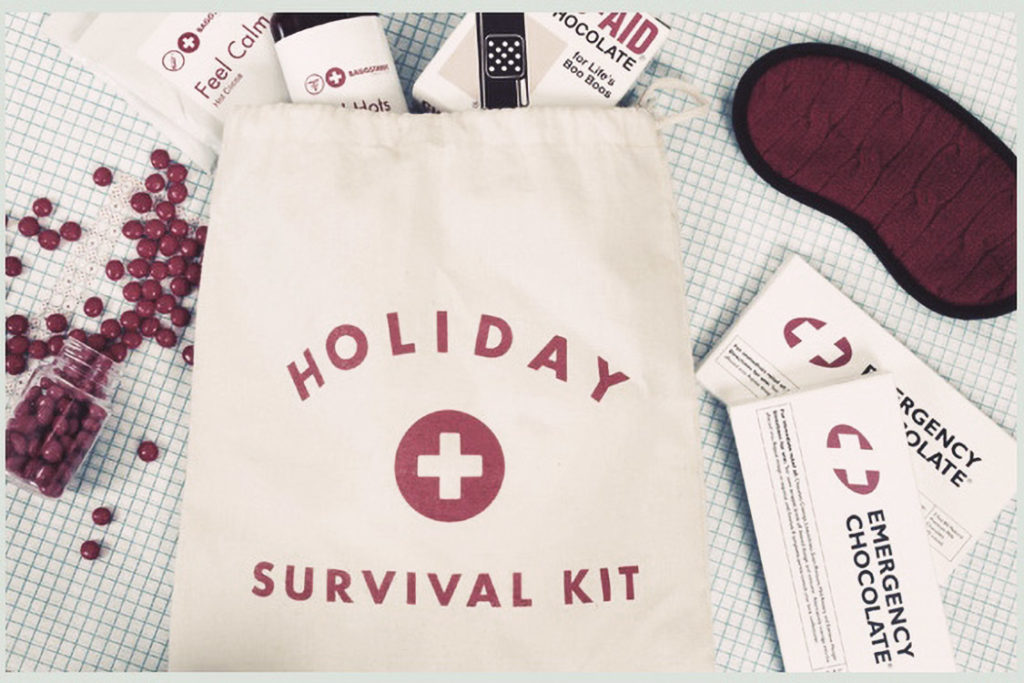
1. Create a holiday season budget
Before you dive into your holiday shopping extravaganza, take a moment to map out a budget for your gifts, menu, and decorations. By setting clear financial boundaries and sticking to them, you’ll have an idea of your expenses upfront, and you can make more intentional decisions.
Decide strategically what’s most important to your festive experience, and use these priorities to pinpoint where you can save (and where to splurge). This approach empowers you to save extra cash while allocating money for your seasonal must-haves.
It’s all about planning and creative thinking to make the holiday season memorable, meaningful, and easy on the wallet.
2. Be realistic and don’t overcommit
During the holiday season, it’s common to get caught up in a flurry of financial commitments—school festivals needing donations, drinks at the office party, obligatory gifts for the boss, and everything in between. However, it’s important to be realistic and learn the art of saying no when necessary.
Yes, Christmas is all about giving, but there’s no use overcommitting to things you can’t afford. Remember, it’s okay to decline an invitation or skip a donation if your budget is already stretched thin. After all, Christmas is about sharing joy, not depleting your bank account! Find non-financial ways to contribute if you need to (like volunteering).
PS. Skip the round robin for the boss’ gift – workplace etiquette says ‘gifting up’ is a no-no.
3. Avoid the credit temptation
Getting caught up in the excitement of shopping and splurging during the holiday season is incredibly tempting. However, those credit card bills will inevitably come back to bite you, and the last thing you want for the new year is extra debt.
So, resist the urge to overspend and stay committed to your budget as much as possible. If you have to use credit, see if your card has an interest-free ‘four instalments’ option; if you can’t safely commit to that, you can’t really afford it anyway.
4. Meal plan, batch prep & freeze
Meal planning can be a lifesaver during the holiday season. I’m not talking about the big day (more on that menu later) but the weeks surrounding it! With a packed schedule of end-of-year concerts, gift shopping and entertaining, it’s tempting to fall back on takeaway.
Leading up to Christmas, start batch cooking and freezing family meals. As the festive season picks up and everyone is flat out, you’ll always have healthy dinners on hand. Not only will it save you time, but it can also help you avoid the takeaway temptation.
5. Stick to simple holiday decor
When it comes to decorating for Christmas, there’s no need to go overboard. A few well-placed festive touches can create a magical atmosphere in your home without an extravagant price tag.
One of my favourite tricks for creating a cosy atmosphere is incorporating candles throughout the living and dining areas. You can mix different types of candles, such as pillars, tapers, small votive candles, and even some beautifully scented ones. As a bonus, you can use candles year-round rather than sticking them in a box for the next 12 months.
6. Don’t go overboard on the Christmas menu
The number one cause of unexpected Christmas expenses is going overboard! This year, avoid getting carried away and thoroughly plan your mains, sides, appetisers and desserts (check out my healthy Christmas recipes for some ideas).
There’s no need to create a festive feast fit for a king. Account for the number of guests, portions per person, and a bit extra to make your shopping list. It’s okay to be generous (and leftovers are always a good thing), but don’t buy ten times the food you actually need, either.
For even smarter Christmas menu planning, choose dishes that make great leftovers and plan a few recipes to use them up between Christmas and the New Year.
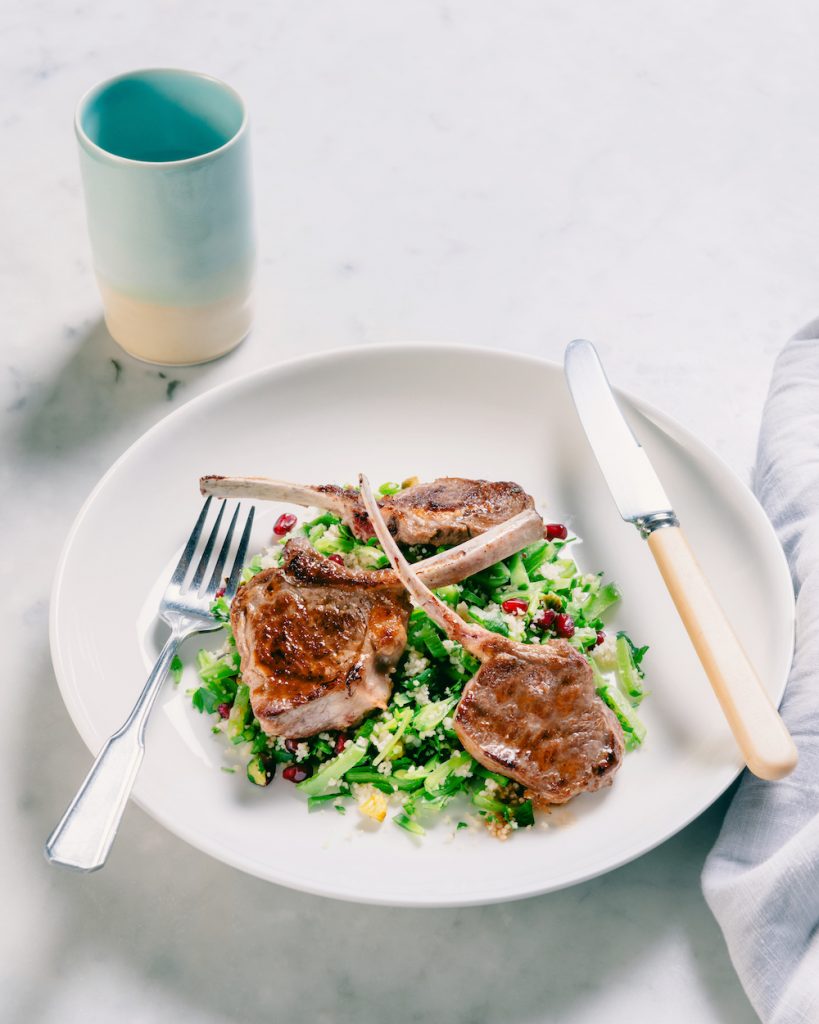
7. Cook more from scratch
More Aussies are cooking and eating at home this Christmas, according to recent Coles research. If you’re looking to save money, it’s a great strategy: cooking your holiday spread from scratch is healthier and easier on the wallet.
Go through your menu plan and consider where you can swap packaged foods for DIY. Do you really need your Christmas chook pre-stuffed, or can you make your own seasoning? A classic pan-dripping gravy only takes a few minutes to prepare, or try this 10-minute cranberry sauce recipe. Of course, skip the ready-to-roast chopped veg and buy the fresh stuff for a fraction of the price.
Plus, it’s an opportunity to get the whole family into the kitchen, baking cookies, making dips, or whipping up desserts. When you look back, those might be the memories you treasure most!
8. Save on your grocery spend
Christmas cookies made with home-brand flour taste the same as the fancy stuff! Don’t get me wrong, quality food can be worth spending on. I always recommend buying the best quality meat you can afford, for example. But plenty of products are just as tasty and nutritious from a store-brand range, including the Coles and Woolies ‘premium’ lines.
Look for cheap seasonal produce – broccoli, cauliflower, and iceberg lettuce are 40% cheaper than in 2022. Fruit lovers rejoice as cherries are about a third of last year’s price, with great value prices on stonefruit and berries, too.
Hunt down specials or bulk-buy options to save extra dollars on Christmas groceries. Loyalty points programs have terrific deals around this time of year, too.
9. Suggest a gift limit or Secret Santa
The cost of Christmas gifts can be eye-watering, especially when you have loads of relatives to shop for. If you’re feeling the pinch, chances are that everyone else is too! Be a hero this year and suggest a strategy to keep things fun without breaking the bank.
One in five Aussies has implemented a gift limit this year, so why not jump on the bandwagon if you haven’t already? For example, suggest that everyone sticks to a $20 or $30 limit for gifts. After all, it’s the thought that counts, not the price tag, right?
Offering to organise a family Secret Santa exchange is another savvy strategy to ensure everyone gets something thoughtful and no one feels burdened financially.
10. Dial back on the booze
Many of us can’t picture Christmas Day without a few drinks! However, the cost can quickly add up if you find yourself hosting the gathering.
Remember that you’re hosting a family gathering, not opening a full-fledged bar! You have every right to buy more affordable options or kindly request that guests BYO drinks. If someone’s Christmas will be ruined without a vintage drop or craft brew, they’re welcome to provide it themselves.
Making a punch or sangria is a clever way to make the most of a cheaper bottle of plonk – check out my recipe for 100-calorie sangria.

11. Make use of leftovers
Don’t let any of your Christmas feast go to waste! Get creative with leftovers and turn them into new, tasty dishes. Not only will this help reduce food waste, but it’s also a great way to save time and effort in the kitchen during the busy holiday season. Who doesn’t love a good post-Christmas toastie?
Freezing leftovers can be a great way to avoid waste – just keep food safety in mind. Don’t freeze those turkey scraps after they’ve been sitting out for hours! Instead, platter up just a portion of the bird and keep the rest in the fridge, then freeze leftovers later that night.
Here are a few more ways to use Christmas leftovers:
- Add leftover meats or roast veg to a healthy frittata
- Use bits of cheese and leftover greens to make spinach & cheese muffins
- Toss leftover seafood into a delicious spicy stew
- Crumble leftover Christmas cookies over chia pudding or a smoothie bowl
- Make pita bread pizzas with leftover roast meats and veg
- Turn leftover mashed veg into veggie fritters (feta optional)
12. Avoid the ‘last minute mark-up’
Let’s face it: when you’re hunting down that perfect present on December 24th, you end up spending a lot more than you’d like to! By getting a head-start early in the year, you can take advantage of the ‘early bird’ effect and save money.
I recommend keeping a big list of all the people you need to buy for, plus a few ideas for each person. Then, keep an eye out for sales – a savvy one-quarter of Aussies do their Christmas shopping with Black Friday discounts. Not only will this save you a few bucks, but it also spreads the financial burden throughout the year.
Bonus tip: if you spot a great markdown on a crowd-pleasing present (think candles, colouring books or a fancy jar of lollies), grab a few for backup gifts.
13. Get the kids creating handmade gifts
I know, it’s a cliché by now! When you think about it, though, what would Grandma treasure the most: another store-bought bath bomb set or a unique handcrafted present from the kids? Not only will you save a few bucks, but you’ll also be giving a genuinely heartfelt gift that’s sure to be treasured (imperfections and all).
Crafting or cooking is a great school holiday activity for the kids, but try not to overcomplicate it. Stick with something that’s appropriate for their age group, or you’ll do the whole project yourself.
Here are some ideas to start with:
- 45 Gorgeous Gifts Kids Can Make
- 115 DIY Christmas Gift Ideas for Everyone on Your List
- My Top 5 Protein Ball Recipes (fill a jar, then add a fancy ribbon and label)

14. Consider a gift-free Christmas
This year’s average gifting spend is $373 – so instead of buying even more stuff no one needs, why not lighten the burden with a gift-free Christmas?
At the end of the day, gifts are just one part of the festive season and certainly not the most important. Especially if you don’t have little ones awaiting Santa’s visit, skipping the presents can reduce the stress for everyone involved.
Focus on making memories instead, whether that’s a vacation or a memorable day spent together. Remember, the best things in life are often not things at all – it’s the people we share them with that truly matter.
15. Make a recovery budget for the new year
If you’ve gone overboard with your holiday spending, don’t panic! Take a moment to sit down and plan a realistic budget for the upcoming months.
If you did go into debt this Christmas, work out a realistic timeline to pay it off. Is there any ‘discretionary spending’ you can cut back on, even just for a few months?
This proactive approach isn’t just about the financial perks, either. It’s about taking charge of the situation instead of getting stuck in anxiety – and trust me, it’s a game-changer!
When budget overwhelm strikes, my top tip is to sit down and plan. From interest rates to grocery prices, there’s so much we can’t control, but instead of feeling helpless, it makes a big difference to focus on what we can do.
Wrapping Up
Take a step back this Christmas and focus on what matters – love, joy, and time spent with loved ones. Saving money is almost a side effect of getting our priorities right! Creating a financially healthier holiday celebration sets us up for success in the New Year.
The reality is that many families aren’t worried about how to celebrate this month. Instead, about a third of Aussies are struggling with the basics, like keeping hungry bellies fed or having a safe place for their kids to sleep.
I understand so many people are doing it tough right now, but if you have a few dollars to spare, why not embrace this spirit of giving this festive season? Here are a few ways to contribute:
- Foodbank: 15% of Australians are facing food insecurity, and a third of those are kids. Every $1 donated provides two meals to Australians in need and helps Foodbank distribute a record 40,000 family food hampers.
- Vinnies Christmas Appeal: Donations help families in crisis keep a roof over their heads, put food on the table, and keep the lights on this holiday season.
- The Smith Family: Help disadvantaged kids keep up with their education by donating or purchasing charity gifts, available from $20 and up (including a printable card or eCard for your gift recipient).
- Two Good Co: Purchase fab Christmas gifts from this store, and 50% of the profits will help unhoused or at-risk women rebuild their lives and regain their confidence.
Donations of $2 and over are tax deductible for all three charities above.
Alternatively, look for local organisations in your community that provide food parcels, housing support and other vital services. If you can manage it, consider donating a few dollars or ask how you can volunteer in the New Year.
Read More
Of course, the budget stress doesn’t end once the Christmas carols fade away. To help your budget hit the ground running next year, here are a few handy articles:
- Top tips for eating healthy on a budget
- My favourite cheap, healthy cuts of meat
- How to rebalance financial power after kids
The post Family Christmas on a Budget: 15 Smart Ways to Save appeared first on Amelia Phillips.
Are Gatorade & Powerade Good For You? Myth vs Fact 17 Dec 2023 5:15 PM (last year)
Let’s talk about Gatorade and Powerade. Many of you might have that iconic orange-capped bottle stashed in your gym bag, ready to rehydrate after a serious treadmill sweat session.
And why not? Sports drinks are touted as the holy grail of workout hydration. When you’re looking to smash your workout, the drink of pro athletes seems like a natural choice. But, have you ever paused mid-gulp and wondered, “Is this neon-coloured liquid actually good for me?”
Gatorade and Powerade may be marketed as a refreshing ‘healthy drink’, but in truth, they’re more like sports supplements and unsuitable for regular consumption. Add one of these to your workout routine, and you might consume more calories than you burn.
It’s not all bad, though: there’s still a time and place for electrolyte drinks. There are also healthier alternatives on the market to keep you well-hydrated.
Let’s dive into the nitty-gritty and unpack the truth about sports drinks.
Are Gatorade & Powerade Healthy For You?
Unfortunately, Gatorade and Powerade are not healthy drinks. Yes, sports drinks contain electrolytes like sodium and potassium, but those are only ‘good for you’ if you actually need them.
Sports drinks are only recommended for endurance exercise over 90 minutes in duration, or in intense heat. During shorter workouts under normal conditions, and for everyday consumption, electrolyte drinks don’t offer any health benefits.
Many people see sports drinks as a healthy alternative to soft drinks or cordial, but this is a major mistake. Like other drinks packed with hidden calories, regularly sipping on Gatorade or Powerade can undermine your health.
Below, I’ll unpack the ingredients in sports drinks and their effects on your body – the good and the not-so-good. Read on to level up your knowledge!
Ingredients in Gatorade & Powerade
Firstly, let’s compare the two most popular sports drinks in Australia: Gatorade and Powerade.
Here are the ingredients for Gatorade in Australia:
Water, Sucrose, Glucose, Food Acids (330, 331), Monopotassium Phosphate, Sodium Chloride, Flavour, Colour (110)
And here are the ingredients for Powerade:
Water, Sucrose, Minerals (Potassium Citrate, Magnesium Sulphate, Calcium Chloride, Sodium Citrate, Sodium Chloride, Potassium Phosphate), Food Acid (330), Flavour, Colours (104, 110).
Gatorade and Powerade have similar ingredients, starting with water, sugar, and electrolytes. Gatorade contains sucrose and glucose, two different forms of sugar, while Powerade contains only sucrose. This is why you might prefer the sweetness of one brand over another!
When it comes to electrolytes, Gatorade contains sodium chloride (table salt) and potassium. Powerade offers magnesium, calcium, and potassium, with a lower sodium content.
Note that the nutrition information on the packaging can be misleading. For example, a bottle of Gatorade says it provides 13% of your daily sodium – but if you look at the fine print, this is 13% of the average adult daily intake, not the recommended (or healthy) salt intake. Big difference!
On top of the refined sugar and salt, sports drinks are also made with artificial flavours, preservatives and colours.
Note that Gatorade and Powerade have different formulas in the USA. Powerade in the States is made with pro-inflammatory high-fructose corn syrup and a few added vitamins.
Pros of Gatorade & Powerade
As a sports supplement, Gatorade or Powerade does what it says on the tin. During intense, prolonged workouts or competitive events, the combination of water, electrolytes and fast-acting carbs can improve athletic performance.
During endurance exercise (over 90 minutes in duration), hydration and energy are key to maximum performance. Heavy sweating means you lose electrolytes and water, which need to be replenished for a healthy balance. Without these minerals, your cells won’t absorb the right amount of water.
On top of maintaining a healthy electrolyte balance, the high-GI carbs in a bottle of Gatorade give you the energy to get through a marathon or intense sports match. This is why sports drink brands can say their products are scientifically proven to enhance performance.
However, Gatorade and Powerade aren’t the only options for exercise hydration. There are no secret performance-enhancing ingredients in the bottle – just water, minerals and carbs. You can also get these from natural sources, minus the refined sugars and artificial ingredients.
Cons of Gatorade & Powerade
Now we understand the benefits, let’s look at the downsides of sports drinks. The same ingredients that provide the perks make Gatorade and Powerade unhealthy for regular consumption: high salt, high sugar, and high in calories.
All of these are great if you’re slogging through a marathon, but certainly not as an everyday drink. Unless you’re working out for more than 90 minutes and need to replenish sweat losses, it’s a case of ‘wrong place, wrong time’.
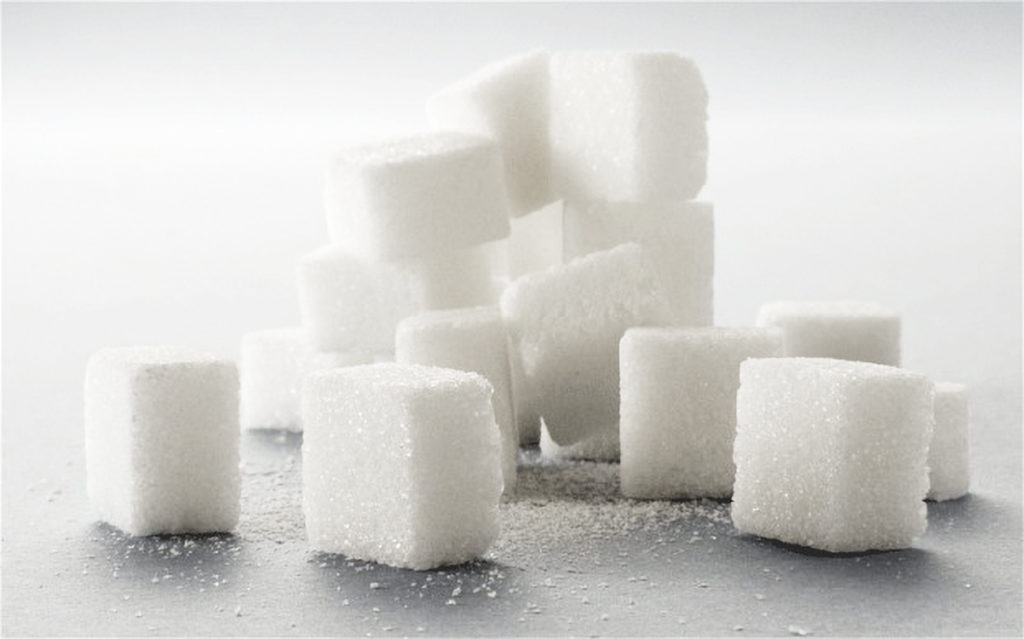
Here’s a closer look at the cons of sports drinks and what they might be doing to your body:
High in Sugar & Calories
Sports drinks like Gatorade and Powerade are designed to provide fast-absorbing carbs during endurance exercise. What does this mean in plain English? They’re packed with sugar!
A 600mL sports drink contains about 670 KJ, the equivalent of 9 sugar cubes. In terms of calorie burn, that’s about an hour of jogging, swimming or skipping. If you’re aiming to lose weight, drinking a Gatorade might cancel out your workout altogether.
The amount of sugar can vary depending on the flavour, but on average, one bottle of Gatorade (600ml) contains around 36 grams. To put that into perspective, that’s almost as much sugar as a can of Coke (39.8 grams). Powerade isn’t far behind, with 34.8 grams per 600ml bottle.
Here’s a comparison of the nutrition facts for blue Gatorade, Powerade and Coke:
| Gatorade Blue Bolt (per 600ml bottle) | Powerade Mountain Blast (per 600ml bottle) | Coca-Cola Classic (per 375ml can) | |
| Energy | 618kJ | 630kj | 675kJ |
| Sugar | 36g | 34.8g | 39.8g |
| Sodium | 306mg | 168mg | 38mg |
High-GI Carbohydrates
The high-GI carbohydrates in sports drinks are rapidly absorbed into the bloodstream, causing an insulin spike. You can expect a sugar crash after this quick burst of energy, leaving you feeling sluggish and tired.
Over time, these hormone fluctuations increase your risk of insulin resistance and metabolic disorders. Overconsumption of sugar is linked to health issues such as obesity, diabetes, and heart disease.
Inflammatory Ingredients
The refined sugars and additives in sports drinks are also inflammatory damaging to exercise recovery and long-term performance. There is a snowball effect with inflammation and weight gain exacerbated by inflammatory illnesses like heart disease and diabetes.
High in Sodium
What about the electrolytes? Don’t they make sports drinks good for you? Well, not really. Unless you’re losing fluids through heavy exertion or illness, you typically get enough of these minerals from your diet.
One essential electrolyte found in sports drinks is sodium chloride – in other words, plain table salt. Australians consume almost double the recommended sodium target (four times more than our bodies need).
Too much sodium increases your risk of high blood pressure, stroke, heart disease and kidney problems. Unless you’re heavily losing fluids, the salt in Gatorade or Powerade is probably doing you more harm than good.
Acidic pH
When we’re scanning the ingredients list, we don’t often stop to think about food acids. These preserve drinks and create a tangy taste to balance out sweetness. Notably, acidic drinks are a major risk factor in tooth enamel erosion. Gatorade has a pH of 3.3 – so it’s just as acidic as juices and fizzy drinks.
Why are Sports Drinks So Popular if They’re Unhealthy?
Why are sports drinks so popular, even with non-athletes? Basically, they’re a very well-funded marketing machine!
When we see elite athletes chugging a Gatorade, we assume that makes it a healthy choice – but many athletes also eat a high-calorie or high-carb diet to match their incredible energy burn. That doesn’t mean it’s healthy for every body and every lifestyle!
It’s the same psychological trap we fall into when looking up celebrity diets or the latest muscle-building supplement. If it worked for someone else, it will work for us, right? Well, maybe – if we have the same body composition, nutrition plan, training regimen, metabolic type… the list goes on.
There’s no benefit to eating like an athlete if you spend most of the day sitting at a desk instead of practising your sprints. Healthy choices are about what your body needs and what will help you get the most out of life.
In most scenarios, sports drinks won’t do you any good, and their high sugar content means they’re best avoided.
Gatorade & Powerade: Myth vs Fact
Let’s take a look at some common myths about sports drinks below.
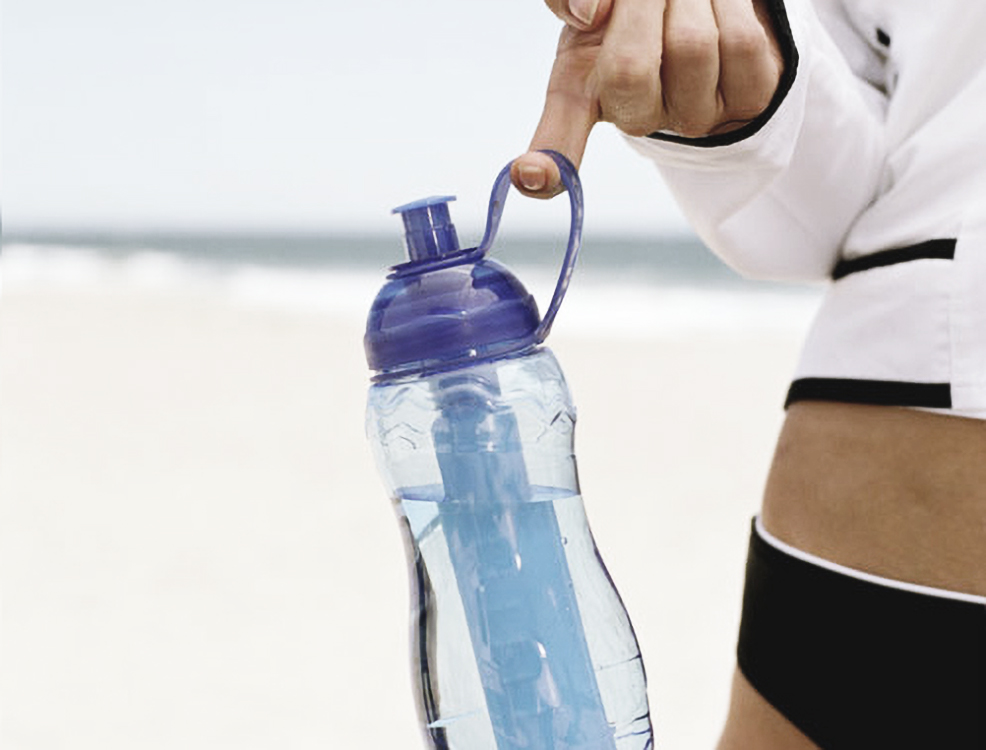
Does Gatorade Hydrate You Better Than Water?
The short answer is no. It’s a myth that sports drinks like Gatorade always provide ‘better hydration’ than water. Sports drinks provide electrolytes and carbohydrates as well – and these are only useful if you need them.
You might need electrolytes to combat dehydration when you’re losing minerals through endurance exercise, heavy sweating or illness. But plain old water will do just fine for the average person hitting the gym or going for a casual jog.
In fact, drinking too much Gatorade can worsen dehydration because of its high sugar content. When there’s more sugar in your bloodstream than water, your body pulls water from other sources to dilute it.
So, save the Gatorade for intense or endurance workouts over 1.5 hours. Otherwise, a big glass of water is much healthier (and a lot cheaper, too).
Is Sugar-Free Gatorade or Powerade Healthy?
Unfortunately, sugar-free and zero-calorie sports drinks aren’t a healthy choice either. Diet sports drinks replace sugar with artificial sweeteners. While this reduces calories, these low-cal substitutes are far from healthy.
Research indicates that low-calorie sweeteners change how we perceive flavours and trick the brain into disconnecting ‘sweetness’ from ‘caloric intake’. When our instincts about food are confused, we’re more likely to crave sweet foods and overindulge when we eat them.
Gatorade Sugar-Free and Powerade Zero are still full of artificial ingredients, including colours, flavours and preservatives. Along with the sweeteners, these are all pro-inflammatory ingredients that are best avoided.
Is Gatorade Good When You’re Sick?
Getting fluids and electrolytes into your system is essential if you’re dehydrated from vomiting or diarrhoea. Gatorade and Powerade aren’t the best choices, though.
Sports drinks aren’t designed for illness, so they don’t have all the right minerals, and the high sugar content in Gatorade or Powerade can actually worsen dehydration.
Gastrolyte, Hydralite or Pedialyte are a better choice for gastro illness, and they’re all available from your local pharmacy. These oral rehydration solutions are available in powdered form, premixed in bottles, or even as icy poles (perfect for fussy kids).
Now, dehydration can be dangerous, especially for children and older people. For little ones refusing water or Gastrolyte, diluted apple juice is the next best thing. If Gatorade is your only option in a pinch, dilute it heavily and get those fluids down ASAP, but don’t make it your go-to choice.
If you have a regular cold or flu (i.e. no fever, diarrhoea or vomiting), Gatorade won’t do anything special to help you recover. Instead, stay hydrated with good ol’ water, herbal tea and broth, plus plenty of nutritious immunity-boosting foods.
Is Gatorade Suitable for Kids?
Sugary drinks are especially dangerous for kids, and sports drinks are no exception. For one, we all know the magnetic appeal of brightly-coloured sugary drinks for kids!
Here are the top risks:
- High-sugar drinks are a major risk factor in childhood obesity and health risks such as type 2 diabetes.
- Acidic drinks cause lifelong tooth damage within 30 seconds of drinking, according to the University of Adelaide.
- Sugar-sweetened beverages have been linked to early puberty in young girls and a higher risk of breast cancer later in life.
- Sweet drinks encourage picky eating and set kids up for lifelong habits.
The recommendation? Keep acidic and sugary drinks to an absolute minimum for kids.
When it comes to sports drinks, it can seem almost magical that this ‘healthy’ drink tastes just as good as cordial. That’s because they’re very similar – in fact, Gatorade has more sugar and calories than the same quantity of cordial!
Here’s how Gatorade compares to Cottees fruit cup cordial:
| Gatorade Orange Ice (per 600ml bottle) | Cottees Fruit Cup Cordial (per 600ml, prepared) | |
| Energy | 618kJ | 528kJ |
| Sugar | 36g | 30g |
| Sodium | 306mg | 66mg |
| Price | $4.00 | 48c |
Now, I’m not advocating for giving kids cordial, either. But unless they’re also junior endurance athletes, sports drinks are really just overpriced lolly water.
The only recommended drink for healthy kids is water, while carbs and electrolytes should come from fruit and veggies. When your pre-schooler has caught another gastro bug, Gastrolyte or Pedialyte is better to rehydrate them.
What is a Healthy Substitute for Sports Drinks?
Sports drinks like Gatorade are undoubtedly convenient (and well-marketed), but they aren’t the only option.
Good old-fashioned water is always the best choice if you don’t need the electrolytes. Coconut water or homemade electrolyte drinks are other popular alternatives for avoiding refined sugars and additives – I’ll talk about the pros and cons of these below.
There are also other electrolyte brands on the market, many offering low-sugar, low-carb or naturally sweetened products. By shopping around, athletes can choose exactly which ingredients they want and which they’d rather get elsewhere.
Let’s unpack some of these options:
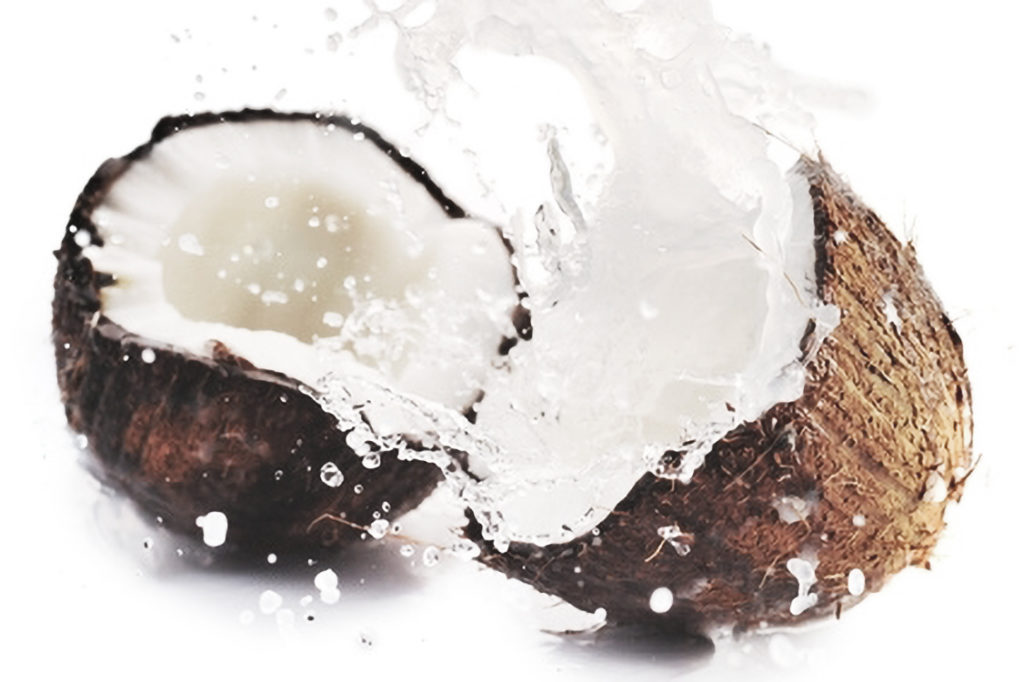
Coconut Water
Coconut water is often recommended as a healthier way to hydrate, but it has pros and cons. On the plus side, it’s 100% natural without refined sugars and additives, and contains electrolytes like potassium, magnesium and calcium.
The cons? Coconut water is particularly high in potassium, meaning it can lead to dangerous hyperkalemia (excess potassium in the blood) for individuals with impaired kidney function, or when consumed to excess. It also contains minimal sodium, the mineral with the biggest impact on exercise hydration.
For an overview, here’s how natural coconut water compares to Gatorade:
| Gatorade Orange Ice (per 100ml) | H2 Coco Pure Coconut Water (per 100ml) | |
| Energy | 103kJ | 89kJ |
| Carbohydrates | 6.0g | 5.1g |
| Sugar | 6.0g | 4.0g |
| Sodium | 51mg | 15mg |
| Potassium | 22.5mg | 200mg |
| Magnesium | 0mg | 5mg |
| Calcium | 0mg | 10mg |
| Phosphorus | 0mg | <10mg |
The high potassium and low sodium content may account for mixed results in studies – in fact, let’s take a look at what the (very limited) research says about coconut water.
A Malaysian study concluded coconut water didn’t offer statistically significant improvements to hydration compared to plain water or electrolyte drinks, but participants did find coconut water easier to stomach. A US study had the opposite finding, where nausea and bloating was highest for coconut water.
Later research into post-exercise hydration found coconut water didn’t hydrate any better than a sports drink, while another trial found sodium-enriched coconut water was more hydrating than sports drinks or water.
Confused? Aren’t we all! Studies have been quite small so far – usually groups of eight to 12 people – so we’ll have to stay tuned for future research into coconut water.
If consuming coconut water before or after endurance exercise, make sure you’re replenishing your sodium levels as well, and don’t overdo it. A small tetra pack of coconut water (330ml) also contains about 16 grams of carbohydrates, which is excellent for energy during long workouts, but means it shouldn’t be guzzled like water.
Always check the ingredients list when buying coconut water, too, since some brands have added sweeteners or flavours. If you can get a fresh young coconut at your nearest grocers, there’s nothing like it!
Homemade Electrolyte Drink
Did you know you can make your own electrolyte drink? There’s no big secret to it – on a basic level, you can recreate sports drinks by combining water, fruit juice and a pinch of salt. For a full range of electrolytes – including potassium, calcium and magnesium – you can buy these in powdered form.
If you’re compensating for heavy fluid loss, it’s crucial to get the proper ratio of fluids and electrolytes, so it’s safest to use a medically-backed rehydration product (or consult with a sports nutrition professional).
Remember that Gatorade only contains sodium and potassium, so if your DIY recipe uses calcium and magnesium, you may already be whipping up a more well-rounded electrolyte drink!
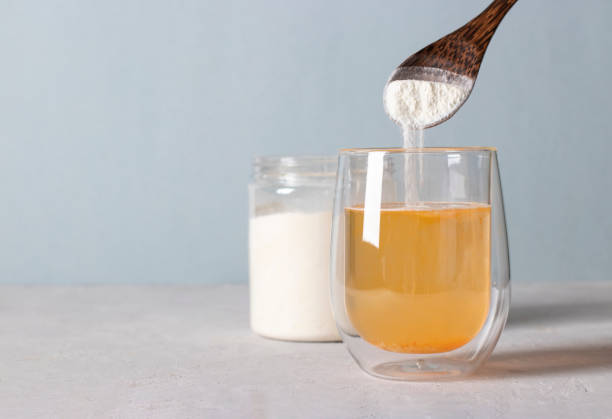
Low-Sugar & Natural Electrolyte Drinks
If you prefer the convenience of premixed drinks, there are plenty of other electrolyte products on the market, from specialty sports products to low-sugar and keto-friendly options. These typically use natural sweeteners like stevia or monk fruit extract and real fruit flavours for taste.
Look for brands that prioritise using whole food ingredients and avoid artificial additives. You can even purchase electrolyte drops and powders without any sugars or flavourings, ready to add to your choice of beverage.
Key Takeaways
So, is Gatorade good for you? The answer is not a simple yes or no – it’s more about understanding what your body actually needs.
If you’re running a marathon or participating in a rigorous sports competition, feel free to reach for that Powerade to replenish lost electrolytes. You know your body best, and you probably have your hydration routine down pat – so don’t let me stop you!
For the average person, though, sports drinks just aren’t necessary. Unless you’re losing enough fluids to need electrolytes, sticking to water and a balanced diet is much better for you.
Here’s to making smarter hydration choices!
The post Are Gatorade & Powerade Good For You? Myth vs Fact appeared first on Amelia Phillips.
24 Healthy Christmas Recipes From a Nutritionist 17 Dec 2023 12:46 AM (last year)
As Christmas approaches, it’s time to face the challenge of creating a healthy holiday menu. After all, the festive season is all about indulgence, isn’t it? Well, the good news is that you can put on a delicious Christmas lunch or dinner without compromising your health goals.
By making mindful menu choices, you can still savour plenty of yummy treats without compromising on taste or health. There’s no need to end up uncomfortably stuffed or guzzling sugar to have a great Christmas with the ones you love.
Why not bring a healthier mindset to the holidays this year? That means ditching the guilt and shame around seasonal food, too. Instead, commit to making nutritious menu choices out of love for your body and the people you share the holidays with.
To help you on your mission, I’ve put together a list of 24 irresistibly healthy Christmas recipes. By filling your plate with wholesome food, you can make this Christmas joyful and wonderfully balanced.
Grab a pen, and let’s start planning a lighter holiday menu!
How to Plan a Healthy Christmas Menu
Before we dive into the recipes, let’s discuss how to create a healthy Christmas menu.
If you’re hosting a gathering this year, providing nutritious options for your guests is also very thoughtful. Even if you can’t avoid demands for the high-calorie classics, including lighter choices in your holiday spread means there’s something that everyone can eat comfortably.
Here are some tips for a healthier Christmas menu:
- Aim for balance and variety: Ensure your menu encompasses all food categories: proteins, carbs, healthy fats, fruits, and veggies. Include a mix of colours and textures in your dishes for a range of nutrients.
- Include powerful foods: Healthy eating isn’t about deprivation – the food that ends up on your plate matters as much as the food you avoid. Supercharge your holiday menu by including nutrition powerhouses like anti-inflammatory foods and opting for quality meat, dairy and produce.
- Consider healthy swaps: Use honey or natural sweetener where sugar is called for; instead of store-bought powdered gravy, make your own from the turkey or chicken pan juices. Every little tweak makes for a more wholesome holiday dinner.
- Make veggies the star: Fill your festive plates with a rainbow of vegetables! They’re low on calories but high on nutrients and fibre, which makes you feel full (and less likely to overindulge in dessert).
- Choose lean proteins: When planning Christmas lunch and dinner, opt for healthy lean meats like turkey, chicken, and fish. They’re lower in calories and fats for a lighter meal. Avoid portions with fat and skin to minimise your saturated fat intake further.
- Think local and seasonal: Support your local farmers this Christmas by incorporating seasonal, locally sourced meat and produce. Not only will it add variety and freshness to your dishes, but seasonal fruit and veg are typically cheaper, too.
Now, with our plan in place, let’s start cooking!
Healthy Christmas Lunch & Dinner Ideas
Now that we’ve got our menu planning tips under our belt, it’s time to roll up our sleeves and dive into the yummy part – the best healthy Christmas recipes! These lighter Christmas lunch and dinner ideas are perfect for summer entertaining.
Here are my favourite nutritious holiday mains and salads:
1. Lamb Cutlets with Pomegranate Cous Cous
Dairy Free, Gluten Free Option

With Aussie lamb the star, this winner of a dish both looks and tastes amazing! Succulent lamb cutlets pair perfectly with couscous tossed with snow peas, pomegranate seeds, pistachios and fresh herbs. Plus, it’s a great main dish that goes light on the grains – for a gluten-free alternative to cous cous, use quinoa instead. Pomegranates are in season from November to March in Australia, adding a seasonal pop of colour and an antioxidant punch.
2. Baby Beetroot & Bean Salad with Feta
Vegetarian, Gluten Free

Festive colours abound in this lively salad, brimming with beets, beans and luscious feta cheese. On top of antioxidant-rich baby beetroot, this dish incorporates broad beans and cannellini beans for variety and protein. Add a simple red wine vinegar dressing, and this healthy salad will make a delightful addition to your Christmas Day spread. It’s perfect to pair all kinds of proteins, including your favourite summer seafood.
3. Warm Kale & Shaved Sprout Salad with Hazelnuts
Vegetarian, Vegan

Looking for the perfect accompaniment to a roast chook or turkey? This wholesome salad is packed with classic holiday flavours and textures. There’s plenty of cruciferous greens to chow down on, with kale and thinly sliced Brussels sprouts, plus the crunch of crispy hazelnuts, salty bacon and zesty orange pieces. Trust me, the combination is irresistible!
4. Smoked Trout Patties with Edamame
Dairy Free, Gluten Free Option
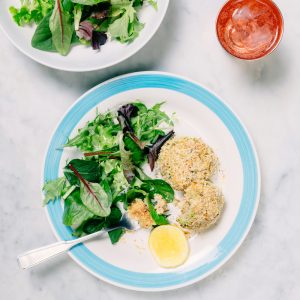
Tasty trout patties are a lighter Christmas lunch option perfect for an Aussie summer. Protein-rich smoked trout and panko crumbs give this dish a luxe twist, accompanied by edamame beans, spring onions and quinoa for a boost of fibre. Smoked trout patties go perfectly with a fresh salad but are also great served on a platter as mini sliders or lettuce wraps. For a gluten-free version, swap Panko for gluten-free breadcrumbs.
Easy & Healthy Christmas Desserts
Onto the sweetest part of any Christmas feast – the desserts. Who said you can’t have your cake and eat it too? These tantalisingly healthy Christmas dessert options will satisfy your sweet tooth while keeping sugar and calories in check.
Add these nutritionist-approved desserts to your festive menu this year:
1. Gluten Free & Refined Sugar Free Christmas Cake
Gluten Free, Dairy Free, Refined Sugar Free

Christmas cake is a holiday classic, but it’s usually packed with sugar on top of all the dried fruit. This healthier Christmas cake recipe is free from refined sugars but is still full of fruit and festive flavour. Hazelnut meal and LSA add plenty of gluten-free goodness, including fibre and omega-3s. To top it off, the cake is sweetened with rice malt syrup, avoiding refined sugars.
2. Roasted Stone Fruit With Brown Sugar
Gluten Free, Vegetarian, Dairy Free Option, Vegan Option
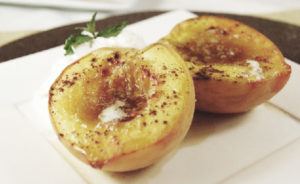
You can’t have an Aussie Christmas without summer stone fruit! This dessert is so delicious that no one will notice it’s good for you.
The method is simple:
- Halve your peaches and plums, remove the stone and place them on a baking tray.
- Place ½ teaspoon of good-quality butter in each stone hole.
- Sprinkle ½ tablespoon of brown sugar over each piece of fruit.
- Bake until butter and sugar are melted and the peach is soft and warm-to-hot.
- Serve with low-fat ice cream or Greek yoghurt.
3. Raspberry & Mocha Lamington Trifle
Gluten Free, Dairy Free Option
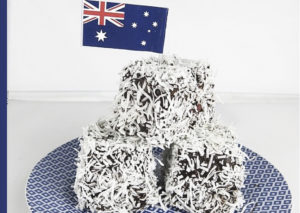
This raspberry and mocha lamington trifle is a unique twist on the classic Aussie dessert. The lamington sponge base is made made with whole coconut flour, and with a pop of fresh raspberry flavour, it’s a healthier option for satisfying your sweet cravings.
For this recipe, follow the method for my Raspberry & Mocha Lamingtons, but keep the raspberries aside and stop before you cut and dip your sponge cake squares!
Instead of making ganache, melt your dark chocolate in some low-fat custard. Layer your sponge cake pieces in a trifle dish with the custard, Noway Collagen Jelly (available from Woolworths), fresh raspberries, and shredded coconut. Sprinkle the top with coconut to finish!
4. Spiced Pumpkin Puddings
Gluten Free, Dairy Free, Nut Free, Refined Sugar Free

If you’re looking for a delicious and nutritious Christmas dessert, these spiced pumpkin muffins make fantastic individual ‘puddings’. Far from your typical dessert, the mashed pumpkin adds a dose of fibre, as well as antioxidants like beta carotene, vitamin C and vitamin E. Coconut flour is a healthier gluten-free alternative to white flour, while coconut oil adds healthy fats and rice malt syrup sweetens without refined sugars. To serve, warm up the puddings and plate them with a scoop of low-fat vanilla ice cream.
5. Mango With Rice Pudding
Gluten Free, Vegetarian, Dairy Free Option, Vegan Option
For a simple five-minute dessert, make the most of Australia’s delicious summer mangoes! Simply slice the mango cheeks into cubes and serve with your choice of vanilla rice pudding (plus a sprinkling of lime zest, toasted coconut or chopped pistachios).
Store-bought: Le Rice is 97% fat-free, while Wicked Sister brand is a bit more indulgent. Fancy Plants also does a vegan rice pudding available at Coles. My favourite from Harris Farm is Ruby & Roy’s Rice Pudding.
Homemade: Try this healthier rice pudding recipe, which uses skim milk and adds Greek yoghurt for creaminess at the end.
For chocolate rice pudding, top with cherries and hazelnuts, plus a few curls of dark chocolate. Delicious!
Healthy Christmas Appetisers & Snacks
No festive gathering is complete without nibbles to satisfy guests until the main course. Instead of sticking with chips and cookies, preparing nutritious snacks gives everyone more nutritious options to munch on.
Healthy doesn’t mean tasteless or boring, either! Try these healthier options for Christmas entertaining this year:
1. Beetroot Hummus with Crudites
Gluten Free, Dairy Free, Vegan
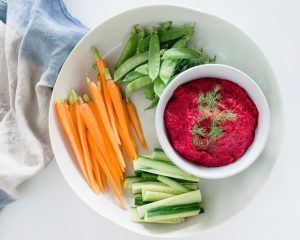
Healthy appetisers don’t get more colourful than this! A vibrant beetroot hummus will be the centrepiece of any Christmas snacking spread. This is one plate of nibbles you’re welcome to fill up on since hummus is packed with protein, fibre, and vitamins from chickpeas and beets. Pair it with an assortment of crisp vegetables and wholegrain crackers for a more-ish appetiser combo.
2. Cacao Almond Rum Balls
Gluten Free, Dairy Free Option, Vegan Option

Consider these almond cacao balls for a delightful, no-bake alternative to Christmas cookies. They’re fun and easy to make – you can even rope the kids into rolling them up! With a combination of dates, almonds, and raw cacao powder, they’re also a natural energy booster full of antioxidants. For a fun adults-only spin, toss in a splash of rum! Now, that tastes like Christmas to me.
3. Cranberry Pistachio Carrot Balls
Gluten Free, Dairy Free Option, Vegan Option
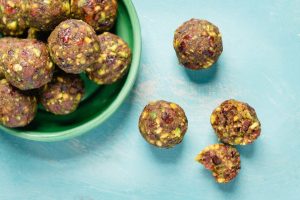
The combination of cranberry and pistachio makes these snackable morsels a nutritious and delicious holiday treat. Add cardamom and rosewater, and you have a seriously luxe snack! Carrots are packed with antioxidants, while pistachios add crunch (along with vitamin B6 and potassium). Cranberries are the highest natural source of phenols, a potent antioxidant – and if your food processor has a grater attachment, it’s even quicker to whip these up!
4. No-Bake Carrot Cake Bites
Gluten Free, Dairy Free, Vegan
A healthier spin on the traditional dessert, you’ll be surprised how much these carrot cake balls taste like the real thing! A combination of carrot, dates and nuts creates sweetness without being overpowering, so these bite-sized morsels are a great accompaniment to tea or coffee with festive-season guests. Ginger and nutmeg are the secret to that ‘carrot cake’ flavour, satisfying your sweet tooth without the sugar or calories.
Healthy Christmas Breakfast & Brunch Recipes
Kickstart Christmas Day with a bang with these scrumptious breakfast and brunch recipes. These recipes are jam-packed with wholesome ingredients, giving the whole family a nutritious energy boost.
Here are four mouth-watering, nutritious Christmas breakfasts that are sure to impress your family and friends:
1. Gingerbread Buckwheat Pancakes with Fruit
Gluten Free, Dairy Free Option, Vegetarian
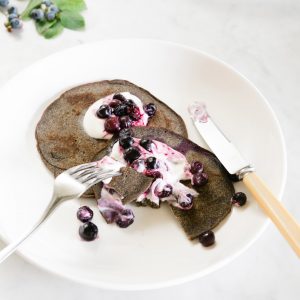
These fluffy banana pancakes use buckwheat flour for a healthy (and gluten-free) alternative to traditional pancakes. To whip up this Christmas breakfast, just follow my buckwheat pancake recipe and add a teaspoon of gingerbread spice mix.
My original recipe tops them with blueberries and natural yoghurt, but the sky is the limit! Strawberries, raspberries, cherries or plums would all be fantastic choices.
2. Mushroom Greens & Ricotta on Sourdough Toast
Gluten Free Option, Vegetarian

Impress your guests with a café-style breakfast that’s deceptively simple to prepare! Not only is this savoury breakfast delicious and easy on the eyes, but it’s packed with nutrients to start your Christmas morning right. Top whole-grain sourdough bread (or a gluten-free alternative) with easy sautéed mushrooms, kale, protein-rich ricotta, fresh herbs and a squeeze of lemon. Magical!
3. Naked Greens & Feta Pie
Gluten Free, Vegetarian

This crustless egg pie is a healthy and versatile option for your festive season menu. It’s great for a Christmas brunch or lunch spread and any occasion where you need to ‘bring a plate’. Alternatively, just whip up a batch and keep it in the fridge over the busy holiday season for a hassle-free, healthy brekky. After all, it’s packed with goodness from eggs, greens, feta cheese, and fresh herbs. Feel free to toss in leftover holiday meat or veg, too!
4. Choc Orange Chia Pudding Parfait
Gluten Free, Dairy Free, Vegan
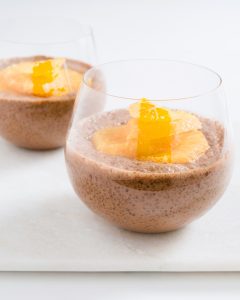
Don’t go past this jaffa-flavoured chia pudding for a decadent yet healthy Christmas breakfast option. Chia seeds are rich in fibre, protein and omega 3s, but the best part is that it all tastes like dessert! For a holiday brekky to satisfy sweet tooths, layer your cacao chia pudding in a glass with some Greek yoghurt. You can even add a few curls of dark chocolate on top!
Healthy Christmas Drinks (Alcoholic & Non-Alcoholic)
It’s easy to get carried away with sugar-filled cocktails this time of year. Luckily, I’ve got you covered with healthier alternatives that are just as delicious. From invigorating berry smoothies to low-calorie sangria, these colourful recipes are refreshing and still deliver a great festive buzz (minus the excess calories).
For more lighter alcohol picks, see my article: Low-Calorie Alcohol: What Can I Drink This Christmas?
Healthy Christmas Cocktails
Whether it’s a BBQ, picnic, or a lazy Christmas brunch, these three healthy sips are a summer menu must-have:

Grapefruit Spritz: This bubbly delight combines a zesty punch of fresh grapefruit juice with the subtle sweetness of blackcurrant liqueur, topped off with a generous splash of brut Champagne or dry sparkling wine.

100-calorie Sangria: Sangria is a ‘party in a glass’, and once you try this low-calorie alternative, you’ll never go back! It combines velvety red wine with the sweetness of fresh pineapple juice and the zest of fresh orange, topped up with a gingery fizz.

Watermelon Gin Fizz: A glass of Watermelon Gin Fizz screams summer in every sip. With the refreshing sweetness of ripe watermelon, the tangy kick of lime, and the effervescence of ginger ale, this cocktail is the perfect refresher.
Festive Sparkling Water
Looking for a refreshing and healthy holiday drink? Adding natural flavourings to sparkling water is a lighter alternative to soft drinks.
If you’re making large quantities, I recommend a SodaStream – not only does it avoid using disposable plastic bottles, but carbonated tap water has a much lower salt content than bottled mineral or sparkling water.

Here are some flavoured sparkling water ideas to get you started:
Lime & pomegranate sparkling water
- Pomegranate
- Lime wedges
- Mint leaves
Mulled spice sparkling water
- Orange slices
- Cranberries
- Cinnamon stick
- Ginger slices
- Star anise
Tropical pineapple sparkling water
- Pineapple pieces
- Lime wedges
- Ginger slices
Mango lime sparkling water
- Frozen mango
- Lime wedges
- Mint leaves
6 Tips for Healthy Eating at Christmas
As delightful as Christmas is, it can sometimes feel like a minefield trying to make nutritious choices! Here are my top five tips for navigating the festive season without having to compromise your health goals:
1. Boost your metabolism with exercise
Getting your sweat on before diving into a festive feast is a great way to boost your metabolism. Keeping up your fitness routine through the holiday season helps burn more calories and decrease stress. Pump up your metabolic rate, and when that scrumptious meal lands on your plate, your body will be ready to handle it like a champ!
2. Don’t skip breakfast or lunch
On Christmas Day, many of us rise and shine early to prepare for the epic feast that lies ahead. It’s tempting to skip meals beforehand, thinking it will make us hungrier for the main event. But instead, do your body a favour and stay on schedule with small, nourishing meals. Fuelling up with protein and good fats means you won’t be starving by dinnertime, and you’re less likely to overeat.
3. Think quality, not quantity
Try to keep the portion size of your meals in check. It’s okay to indulge but remember, you don’t have to devour twice as much food as usual to enjoy the day. Plus, we all want leftovers, right? When it comes to turkey, ham, and other proteins, stick to a palm-sized serving. Fill the rest of your plate with veggies or salad, and when it comes to sides like mashed potatoes or stuffing, add a little bit to enjoy mindfully.
4. Keep an eye on the canapes
It’s especially easy to get carried away when we’re chatting and munching at the same time, but those little bites before the main meal can add up quickly! Just because they are small bites doesn’t mean you should go overboard. If you can’t keep the snacking impulse in check, go for the healthiest appetisers, like raw veggies with hummus.
5. Avoid grazing straight from the fridge
When preparing food or cleaning up, it’s all too easy to graze on leftovers and ingredients straight from the fridge. But this mindless nibbling can add up quickly! There will be so much yummy ham and crumbling bits of pudding in the fridge, so feel free to tuck in – but put them on a plate and sit down to eat slowly. Trust me, you’ll enjoy the taste more when you’re not guiltily reaching into the refrigerator!
6. Stay hydrated (especially if you’re drinking)
With all the rich food and alcohol, staying hydrated is crucial. Aim for at least eight glasses of water a day (more if you’re drinking or spending time in the heat), and try to alternate between alcoholic drinks and water to avoid overindulging. This will also help prevent a Boxing Day hangover!
Next Steps
Remember, Christmas is a time to celebrate and make memories with loved ones. The goal is to enjoy yourself without obsessing over food or weight – and all these tips are designed to help you do that!
It’s not about putting even more rules and restrictions on yourself. Instead, it’s about planning ahead and making sure you always have delicious, healthy options on hand. Being prepared with simple strategies and nutritious recipes helps you make mindful choices while enjoying the festivities stress-free.
If you’re used to battling guilt and temptation over the festive season, it’s time to break the cycle this year! Take a deep breath, plan ahead and find that middle ground, where you’re enjoying delicious treats with intention, confident that you’re still fuelling your body with the good stuff.
A healthy holiday season shouldn’t mean stressing about your eating habits. Instead, it’s setting yourself up for a wonderful Christmas filled with joy, laughter, good food and even better company. Cheers to that!
Here are a few more articles to help you have the healthiest Christmas yet:
- Top Tips to Reduce Stress this Holiday Season
- 12 Days of Christmas Workout Challenge (Plus Festive Fitness Tips)
- How to Celebrate Christmas on a Budget
The post 24 Healthy Christmas Recipes From a Nutritionist appeared first on Amelia Phillips.
25 Tips to Survive Christmas Holiday Stress 16 Dec 2023 7:10 PM (last year)
Ah, Christmas! What a fantastic time of joy, carols, twinkling lights, and… let’s not forget the stress, shall we? While the holiday season is meant to be a time of celebration, it can also leave us feeling pretty frazzled.
Juggling everything from Christmas shopping to cooking that perfect roast, and the ins and outs of family dynamics, it can all get a little overwhelming.
A few years ago, just two days into our holiday, my husband turned to me and said he’d be more relaxed if he went back to work! That was the moment it hit me: something had to change.
Since then, I’ve made it my mission to learn from all my over-committing mistakes. I’ve got 25 super handy tips to share so you can ditch the overwhelm, stick to your Christmas budget and fully embrace the holiday cheer.
Read on to dial down the stress this festive season!
Get Organised & Expect the Unexpected
Hold on to your Santa hats because the first step to a stress-free Christmas is getting yourself organised! It’s not as exciting as decking out the tree or wrapping presents, but trust me, it’s worth it.
Avoid the anxiety by planning like a pro this Christmas, and have a backup for when the unexpected comes knocking on your door (because, let’s face it, it will!).
Here are my smartest Christmas planning tips:
1. Make a Festive Season Calendar
The festive season is jam-packed with family events, deadlines, and commitments galore. To avoid feeling overwhelmed, you need a clear overview of what’s happening and when.
Create a holiday calendar where you can jot down all your important dates and deadlines. Factor in all the essential tasks like gift shopping, decorating, and Christmas menu prep.
Once you’ve made your holiday calendar, prioritise tasks based on urgency and importance, then break down larger tasks into smaller, more manageable ones. This will keep you from feeling totally swamped or running around at the last minute.
2. Keep Cheese & Champagne In The Fridge
Have a big bunch of surprise visitors? Always keep a few bottles of Prosecco (around $10 a bottle) in the fridge during the festive season. I like keeping some fresh berries in the fridge to jazz up the drinks a little.
For nibbles, go with the most versatile snack option for holiday visitors – cheese! Simply stock your dairy drawer with a soft goat cheese (garnish with fresh ground black pepper), a hard cheddar, and camembert. Pair with water crackers, fig jam, sliced apples, strawberries and a bunch of grapes. Add height to the platter with some breadsticks in an upright jar.
Keen to put a healthy spin on holiday snacking? Opt for lower fat cheeses and wholegrain crackers, or prepare veggies and hummus for dipping.
3. Don’t Be Afraid to Say No
During the holiday season, it’s easy to find ourselves caught up in a whirlwind of activities, from office parties to school events and everything in between. However, it’s essential not to compromise your wellbeing or mental health.
The most critical skill? Learning to say no when necessary. Remember, it’s perfectly okay to decline an invitation to a holiday event or party if you’re already feeling stretched thin.
Setting boundaries with family keeps things manageable, too. For example, let your relatives know you’ll need a day’s notice to entertain guests. If they show up on your doorstep anyway? Unfortunately, you’re “just heading out, ” so it’s too bad for them!
By setting clear expectations (and sticking to your guns), you can create the manageable holiday season you want to see.
4. Stock the Freezer with Meals
Meal planning can be an absolute lifesaver during the busy holiday season. It’s not just about the big day (we’ll get to that menu later) – I’m talking about the hectic weeks before and after.
As the countdown to Christmas begins, it’s time to start batch cooking and freezing some trusty family meals. By stocking the freezer, you’ll have a stash of delicious and nutritious dinners ready, even on the busiest days.
Not only will this save you precious time, but it also sets you up to make healthy choices (and avoid the temptation of takeaway).
Master Christmas Menu Planning
Planning the Christmas menu might kick off the cold sweats, but it doesn’t have to be that way! No more last-minute recipe hunts or stressful supermarket runs. With some strategic planning, you can whip up an irresistible Christmas feast while saving time and money.
Here are my top strategies for stress-free hosting this year:
5. Plan & Shop for Groceries Early
This year, get ahead of the game by organising your menu ahead of time. List all your holiday meals, snacks, and treats, along with a timeline of when you’ll need to cook them. Next, create a complete shopping list for the ingredients you need, and keep an eye out for anything you can pick up on special.
If there’s anything you can prepare in advance, use your fridge and freezer space wisely to cut down on Christmas Day cooking. The more you can do in advance, the more you can relax and enjoy yourself!
6. Pare Back the Menu
When it comes to festive meals, there’s no need to go all out with a four-course extravaganza. Instead, why not stick to your family’s tried-and-true favourites? Stick to a simple main and a few sides, with a dessert you can prepare beforehand.
If all else fails, why not celebrate in true Aussie style with a classic backyard barbie? Head to the local butcher and grab some tasty lean sausages, then ask your guests to contribute by bringing a salad, dessert or drinks. That way, you won’t find yourself playing chef all day.
7. Check for Dietary Restrictions
As you assemble your Christmas menu, check in with all your guests about dietary restrictions or preferences. Whether it’s a food allergy, intolerance, or personal choice like vegetarianism or veganism, you don’t want to find out at the last minute!
Being a gracious host means ensuring everyone is included, even if it takes a bit of extra effort. If you’re unsure how to accommodate someone, don’t be afraid to ask them!
If you have a lot of varied dietary needs in the family or some very sensitive allergies in the mix, a ‘bring a plate’ strategy might tactfully ensure there’s something everyone can eat.
8. Shift Tasks Off Your Plate
If you’re hosting, don’t hesitate to ask for help with any tasks you can delegate. Can one of your siblings take care of the table decorations? How about picking up drinks and ice? Don’t feel like you have to do it all this year because there’s no shame in sharing the load.
This goes double for preparing food – stick someone on BBQ duty and get the millennials of the family shaking Insta-worthy cocktails. Having everyone involved creates a fun bonding experience and takes some of the pressure off, so you can enjoy the party, too.
9. Include Healthy Meals & Snacks
The holiday season is usually a time for indulgence, but that doesn’t mean we have to abandon healthy habits! It’s incredible how much better you feel when you keep your energy up with nutritious meals and snacks.
Avoid the holiday ‘blah’ feeling by adding healthier options to your Christmas menu, like salads and veggie-based snacks. Remember to stay hydrated with plenty of water, too! Physical and mental wellness go hand-in-hand, so taking care of yourself sets you up for a stress-free Christmas season.
Coast Through Family Conflict
Amidst all the chaos, don’t forget the true meaning of Christmas – spending time with family and spreading joy and kindness. Actually, that’s not how many family gatherings tend to go… what to do?
Below, you’ll find my best tips to keep a clear head and avoid any family feuds:
10. Be Realistic & Come Prepared
Family dramas during the holidays are almost guaranteed! Be realistic and ensure you’re mentally and emotionally prepared for what might come up.
If you’re having your partner’s parents over for lunch, for example, have a discussion beforehand on how you’ll navigate any recurring challenges. Be prepared to have each other’s backs, including a secret signal if someone needs ‘time out’.
Of course, your relatives may be so delightful this isn’t necessary, but when entertaining guests, a little bit of secret code goes a long way!
11. Try a ‘Respect & Deflect’ Strategy
Here’s a tip for the holidays: treat your family members like you would a colleague. In other words, be respectful, stay professional and keep the peace!
Harvard-trained etiquette expert Sara Jane Ho agrees, recommending that we respond to passive-aggressive comments with a breezy smile. “Just agree and play along,” she says, especially when dealing with in-laws.
Avoid reacting to personal comments in the moment, and try to enjoy the day. Anything that feels out of line can always be addressed later in private.
12. Avoid Toxic Topics
A 20-year study by Purdue University confirms family conflict is most common around those two dreaded subjects: religion and politics.
During the holidays, try to accept family members as they are, even if they don’t meet all your expectations. Avoid getting tanked with the emotional negativity of clashing viewpoints, and steer clear of serious talk during this time of the year!
If an argument with a sibling or cousin is unresolved, take that conversation off the dinner table. Be grateful you’re all together, and fake a smile if you have to.
13. Skip the Social Comparison
Holiday get-togethers are the perfect breeding ground for feelings of inadequacy. Right when we’re weighing up how we feel about the year, we’re hearing about everyone else’s annual accomplishments and milestones.
Remember, that urge to compare ourselves to everyone else is normal, but it can also send our emotions spiralling needlessly. For example, the Within-Family Differences Study found it’s common for siblings to question who the “favourite” really is – and that most of the time, our assumptions are totally wrong!
Don’t get caught up in comparisons. Remember, life isn’t a competition, and your journey is entirely your own.
14. Keep an Eye on the Alcohol
The festive season is usually associated with plenty of booze. It’s fine to enjoy a drink or two this Christmas, but make sure you keep an eye on how much alcohol you and your guests consume.
Alcohol can lower inhibitions, heighten emotions, and increase the likelihood of saying something hurtful that you may regret later. Plus, you want to be present to fully enjoy (and remember) the day!
If you’re hosting, limit the amount of alcohol available and make sure no one is drinking on an empty stomach. Even if you’re feeling stressed, avoid using booze to manage it, or you may find yourself with more drama than you planned.
Gift Smarter This Christmas
As we venture into the season of giving, shake off the advertising jingles and remember it’s the thought that counts! Make this Christmas more meaningful and less stressful with these savvy gifting tips:
15. Do Your Prezzie Shopping Early
To dodge the last-minute holiday shopping frenzy, kickstart the excitement early and create a gift list of everything you need to snag. Check it not once, twice or even thrice to ensure you don’t miss anyone!
Going the online shopping route is always handy since you’ll dodge the chaotic pre-Christmas crowds and take advantage of discounts, making this festive season more budget-friendly.
16. Suggest a Gift Limit or Secret Santa
Having a big extended family means gift-giving can get overwhelming. How about suggesting a dollar limit for gifts this year? If buying individual gifts still feels daunting, how about a Secret Santa?
Remember, even if you can comfortably afford gifts for everybody, you never know who else might be struggling this year. Far from being stingy, a gift limit or Secret Santa policy ensures no one is overburdened by holiday gifting.
17. Gift Experiences, Not Things
If you’re in a time crunch and still haven’t found that perfect gift, there’s no need to stress! Instead of scrambling, jump on a site like RedBalloon to find an experience gift. There’s something for all ages and interests, so explore the options and pick something they’ll love.
Experience gifts are more personal than a gift card, but save you the hassle of running all over town to find a present. Plus, they’re eco-friendly and easy to wrap!
18. Consider a Gift-Free Christmas
At the end of the day, gifts are just one aspect of the festive season. Instead of buying more stuff, why not make it a gift-free Christmas this year? Especially if there are no little ones in your family, skipping the presents can reduce the stress for everyone involved.
Alternatives to Christmas gifts include heartfelt cards or a donation to charity. You can do this Secret Santa style, where each person picks a charity their Santa donates to or pool your donations for one special cause. You can also focus on making memories with a special experience, like a trip or outing.
Adapt Your Wellness Routine
As the hectic holiday season arrives, it’s easy for our health and fitness routines to fall by the wayside. I’m here to tell you it doesn’t have to be that way! It’s time to adapt – not abandon – all the healthy habits you’ve built this year.
In this section, I share my advice for maintaining your wellbeing through the Christmas season:
19. Banish Guilt & Aim for Balance
If you need permission, here’s your ticket to enjoy the festivities guilt-free. Instead of fretting over the number of calories you’re consuming, remember that stress contributes to weight gain anyway, so you may as well give yourself a break!
When making healthier Christmas menu choices, focus on getting extra nourishment into your body through this stressful season, not body-focused guilt or shame.
Most importantly, don’t deprive yourself of joy because you feel like you don’t deserve it – after all, it’s not like you do this every day! Go ahead and have that dessert.
20. Exercise for Your Mental Health
Holiday season stress can lead to anxiety and low moods, sabotaging all that Christmas joy and cheer. However, there is good news! Exercise is a natural mental health booster, lowering stress hormone levels and boosting mood.
People feel happier and more positive after a workout, so here’s a challenge: why not kickstart your days this December with an early morning workout? It’s the perfect time to squeeze in a sweat session without all the distractions, and you’ll be ready to tackle the day with a positive mindset.
As a bonus, working out first thing in the morning boosts your metabolism, helping you feel energised and burn more calories all day.
21. Get Enough Restful Sleep
When you’re tempted to stay up late wrapping gifts or watching ‘Love Actually’, remember a lack of sleep can sabotage your mood, energy levels, and immune system. Yikes!
Getting enough rest also helps regulate your appetite and body weight; as sleep goes down and stress increases, leptin levels drop, making us crave fatty foods. Aim for 7 to 8 hours of sleep every night to stay on top of it.
21. Stay Hydrated
Amidst the hustle and bustle of holiday festivities, drinking enough water tends to slip off the radar until we’re parched. Staying hydrated should be a priority, especially when we’re out and about in the scorching summer heat.
Make it your mission to down at least eight glasses of water daily. Not only does it regulate body temperature and aid digestion, but it also fuels your metabolism for plenty of energy.
Oh, and a little tip? Try to minimise the sugary drinks. They won’t do you any favours when it comes to staying hydrated.
Make Self-Care a Priority
Amidst all the hustle and bustle of the holidays, taking care of yourself is important, too. Here are a few tips to stay on top of your mental and physical well-being during this busy time:
22. Establish a ‘Me Time’ Routine
It may be the season of giving, but you have to take care of yourself to take care of everyone else! When the demands and expectations around Christmas can be overwhelming, it’s crucial to make time for yourself.
Take intentional breaks through the day to centre yourself, recharge and rejuvenate using whatever natural stress relief methods work for you. These precious moments of self-care help maintain a sense of balance and calm amidst the holiday chaos and keep a lid on all that stress. Remember, caring for yourself is not selfish; it’s necessary.
23. Focus on Being Present
There are only so many Facebook posts you need to see wishing you a Merry Christmas! Instead of endless scrolling, take the time to disconnect and spend quality time with your family.
Take your kids to the local park or beach, pack a Frisbee or ball for a game of catch, play some beach cricket, or even get digging with a bucket and spade to build a record-breaking sandcastle. If there’s one thing I recommend over the holidays, it’s finding joy in simple pleasures and being present in every moment. So, take advantage of the annual ‘time out’ to reconnect and make memories.
24. Find the Silver Lining
One of my favourite tips for the season is to keep a gratitude journal. As we get closer to the end of the year, take the time to stop and reflect on the things that matter to you in life. By dedicating a few minutes each day to count your blessings, you’ll cultivate a mindset that centres on joy and fulfilment.
It’s also a touchstone for navigating holiday conflicts – after all, we tend to take people for granted until they’re no longer with us. Remembering what you cherish about your loved ones helps shrug off the small potatoes.
25. Don’t Forget to Breathe
When things start to feel overwhelming, take a deep breath and remind yourself that this too shall pass. It’s just one day out of the year, and burning the turkey is just one fleeting moment in the grand scheme of life. It’s a bit flowery, I know, but it’s true!
Amidst the chaos and challenges of the holiday season, it’s important to keep things in perspective and let yourself enjoy what makes Christmas special. Take a deep breath, let the small stuff slide, and make every moment count!
Wrapping Up
Christmas is meant to be a time of happiness and celebration, not stress and chaos. I learned many of these tips the hard way – so in sharing these strategies, I’m hoping other mums can benefit from a less frazzled festive season.
If there’s one tip you take to heart, remember to prioritise your well-being during the holiday season. Remember to listen to your body and mind. Plan ahead, keep things simple, and don’t overcommit – after all, it’s a celebration, not a competition.
You don’t need to push yourself for a bigger and better Christmas celebration. In fact, the best holidays are usually the years we keep it simple and let ourselves be present instead of running around to make the day ‘perfect’ for everyone else.
Wishing you a joyful and stress-free holiday season!
For more strategies to survive the silly season, don’t miss these articles:
- Smart Ways to Save Money This Christmas
- 24 Healthy Christmas Recipes From a Nutritionist
- Festive Fitness: 12 Days of Christmas Workout Challenge
The post 25 Tips to Survive Christmas Holiday Stress appeared first on Amelia Phillips.
12 Days of Christmas Workout Challenge + Festive Fitness Tips 12 Dec 2023 10:27 AM (last year)
With a Christmas pudding here and a cocktail there, our health goals tend to take a back seat over the holidays, along with our usual workout routine.
I completely understand why: there are presents to buy, family and friends to entertain, the kids are home from school, and if you’re lucky, you might even be jetting off on a big blowout holiday. In other words, squeezing in a big gym session this time of year is not easy!
Your schedule may be more stuffed than the turkey, but that doesn’t mean it’s impossible to get active. Instead of pushing your luck (and swearing you’ll get to tomorrow’s class), why not work out at home instead?
Don’t get me wrong, there’s no shame in enjoying some time off (and a few glasses of bubbly). Instead, it’s all about balance and moderation through the holiday season – trust me, every bit of effort counts, and your body will thank you!
Looking after your physical health through December is the best way to start the new year feeling fab. If your fitness routine usually falls off the wagon during the festive season, these 12 Christmas-themed workouts are exclusively for you.
12 Days of Christmas Workout Challenge
Grab your water bottle and prepare to sweat through the season with my 12 Days of Christmas-themed workout challenge!
There’s something fun for each day leading up to December 25th, and they’re designed to be short but intense, so you only need a few minutes to tick off your daily activity.
All 12 workouts can be done anywhere: in your living room, bedroom, backyard, kitchen or even the airport (if you don’t mind some strange looks).
All workouts should begin after a quick warm-up, between 5 to 7 minutes. I recommend a jog, skip or combination of butt kicks, jumping jacks and bodyweight squats.
Get pumped, and here we go!
Day 1
Kickstart the season with a plyometric workout
Feeling tired just thinking about the celebrations ahead? Kickstart your holiday season with this energising plyometric workout – it will give you the spark you need!
How to do it:
1-minute blast of each exercise for 3 rounds, 1-minute rest in between:
- High Knees
- Mountain Climbers
- Jump Squats
- Power Pushups (can do on knees)
- Tuck Jumps
- Burpees
Day 2
‘All I Want for Christmas’ arm workout
Are strong, toned arms on your wishlist this year? Try Tracy Anderon’s 16-minute arm workout.
If you haven’t heard of Tracy, this woman is known as the arm workout whisperer. She’s trained celebrities like Gwyneth Paltrow, Jennifer Lopez and Jessica Alba, so she knows what she’s on about.
Plus, it’s short and sweet: 16 minutes of this rigorous arm workout is all you need this holiday season.
How to do it:
Day 3
Seasonal stair challenge
Today’s challenge is simple: maximise your steps and always take the stairs everywhere you go. Whether you’re still at the office or braving the shopping centre crowds, aim for 10,000 steps in total.
Day 4
Summer beach body workout
Prepare to move from head to toe with Tone It Up’s full-body workout video. Twenty-four minutes and a set of dumbbells is all you need to feel this one in your muscles! After you’re done, reward yourself with some fun in the sun.
How to do it:
Day 5
Bubbly burpee challenge
No, I’m not talking about the kind that comes in a glass! Before you indulge in all things sparkling for the holidays, boost your metabolism with burpees.
How to do it:
100 burpees, as fast as possible with good form. What time did you clock?
Day 6
Retro summer aerobics workout
Enjoying the vintage-inspired summer of your dreams? Here’s another retro gem from the time capsule: Jane Fonda’s 80s-style floor workout.
This video is an oldie that will have you smiling the whole way through! I love that it’s so retro and still makes you feel the BURN. Put on your best 80s-inspired workout gear, and you’ll have a blast.
How to do it:
Day 7
Christmas cheer rear workout
You know the old saying, right? Here is a circuit to make that bum burn!
How to do it:
3 rounds:
- 50 squats
- 50 alternating lunges (1 leg = 1 rep)
- 50 hip raises (squeeze 5 seconds and lower)
Finish with 3 rounds of 1-minute skipping. Count your reps per round – for an extra challenge, try to keep beating the previous round, or try some of these skipping variations.
Day 8
Santa’s sleigh ab circuit
When you think about it, Santa works hard stacking the sleigh and hauling around sacks of goodies – so there must be a strong set of abs under that round belly!
Take inspiration from the man in red today and focus on your core strength.
How to do it:
4 rounds to feel the burn:
- 25 sit-ups
- 25 reverse crunches
- Plank 30 seconds
- 25 bicycle crunches
- 25 twist toe touches (hand to opposite toe)
Day 9
Present push-up challenge
Want to really strengthen those arms so you can carry more presents? Do this push-up challenge twice today whenever you get a few minutes to spare. Tally your total reps, and you will be amazed!
How to do it:
5 rounds of pushups to failure – knees or toes!
Rest 30 seconds between the first 3 rounds, 60 seconds for the last 2 rounds
Day 10
‘Step and shop’ challenge
It’s the last chance you have to tick off your Christmas list – luckily, racing around the shops counts as incidental exercise!
“Shopping is my cardio,” said Carrie Bradshaw – that’s your personal philosophy today. Remember, to get everything on that last-minute gift list, you’ll have to go fast!
For an extra challenge, park further away from the entrance (you may not have a choice on this one!) and stash your bags in your car rather than using a trolley.
Day 11
Christmas Eve endurance challenge
Patience is a virtue, particularly at this time of the year! Test your endurance while waiting for Santa with these little fitness challenges.
How to do it:
- Exercise 1: Wall Sit
- Exercise 2: Sit Ups
- Exercise 3: Tricep Dips
- Exercise 4: Push Ups
Each exercise is done 3 times.
- 1st round: 30 seconds
- 2nd round: 45 seconds
- 3rd round: 60 seconds
60 seconds recovery between each round (increase or decrease if required)
Day 12
MERRY CHRISTMAS!
It’s the big day! Today’s mission is to enjoy the company of your family and friends. Plus, it’s time to tuck into all that festive food and wine (preferably in moderation, but that’s up to you!)
You’re not totally off the hook, though – start the morning right with a 45-minute run, jog or power walk. It’s a great way to get centred and boost your metabolism before the celebrations commence! Jump out of bed and get it done first thing for a guilt-free day of treating yourself.
My Top 7 Holiday Season Fitness Tips
This time of year is when many of us lose perspective on ‘moderation’, and our oh-so-balanced routines fall out the window.
With a few handy tips, you can stay on track for your fitness goals through the summer holidays.
Here are my top fitness strategies for the Christmas period:
1. Make realistic plans (and backup plans)
Let’s face it – driving and parking anywhere is a nightmare the closer we get to December 25th. This time of year, the extra hassle of getting to the gym will tempt you to skip it altogether.
My ‘12 Days of Christmas’ fitness challenge above is a great place to start. At the end of this article, you’ll also find links to more home-based workouts to carry you through the summer holidays.
2. Go for short, intense workouts
If you’re pressed for time, you’re in luck: research shows even a short 15-minute workout can give you solid results. High-Intensity Interval Training (HIIT) uses short, intense bouts of exercise followed by recovery periods, providing ‘similar fitness benefits as continuous endurance workouts’ in a shorter timeframe. Win!
3. Work out in the early A.M.
My top holiday fitness hack? Skip the sleep-in and exercise first thing in the morning – there’ll be no chance of something ‘coming up’ or surprise guests dropping in! When you squeeze in that 30-minute workout or run early, you’ll still be able to relax and spend time with your family for the rest of the day.
4. Make exercise your self-care routine
While it’s meant to be “the most wonderful time of year”, the holidays are often the most stressful. Exercise is a great tool to manage the holiday madness – it reduces stress hormone levels and gives you a rock-solid excuse to take time out. When it’s all getting too much, take a break from the family, go for a jog and enjoy those feel-good endorphins!
5. Balance your calorie burn
If you’re working towards a weight loss goal, the temptation of Christmas treats can add a lot of stress to the season. My ultimate recommendation for worry-free indulgence? Stick to the the good ol’ calories in vs. calories out model. When you want to treat yourself without worry, plan a big calorie-burning workout. Maybe it’s a three-hour hike, a high-intensity RPM class, or a good solid run.
6. Book a fun run or event in January
Lock yourself into an event in the New Year, and you’re more likely to stay consistent with training throughout the festive season. Look around your local area – there are loads of community park runs! Team up with a training buddy (like a friend or neighbour) and keep each other motivated.
It’s also a great excuse to take some time out. Your least favourite relatives are overstaying their welcome after lunch? Sorry, training for a 5K; gotta dash!
7. Be kind to yourself
This time of year can be unpredictable, so don’t get hung up if things don’t go to plan. Whether it’s unexpected guests, last-minute present shopping or waking up with a hangover after too much Christmas cheer, it’s not the end of the world to skip a workout.
Remember, it’s only one day out of 365 – do your best, roll with the punches, and get through the silly season!
More Home Workout Ideas for the Holidays
Here are more home workouts to keep you active during the festive season:
- Best Summer Beach Workout Circuit
- Full Body Workout – No Equipment Needed
- Body Weight AMRAP Workout
- High-Intensity Cardio Circuit
- My Top 4 Butt Exercises
The post 12 Days of Christmas Workout Challenge + Festive Fitness Tips appeared first on Amelia Phillips.
How to Get Motivated to Exercise (And Keep It Up Long-Term) 1 Dec 2023 11:59 PM (last year)
Have you started an exercise program with the best of intentions, only to lose motivation and quit? You’re not alone!
According to Australian guidelines on physical activity, we should be active most days of the week (if not all of them). The goal is at least 150 minutes of moderate-intensity exercise per week, or 75 to 150 minutes of vigorous-intensity exercise – including at least two days of muscle strengthening exercises. That’s 30 minutes of exercise five times per week. Sounds doable!
However, most Aussies aren’t getting anywhere near this target. Why is it that some people can stick to their programs and some not? What are the tricks people who never skip a workout use?
The truth is that for some of us, exercise = work. Running, yoga, fitness classes, and weight training all require time and effort. If it were easy, everyone would be doing it, right?
For many of us, our attitude towards exercise is more like our attitude towards Brussels sprouts: we do it because we were told it’s good for us, but really, yuck!
If you’re struggling with workout motivation, this guide is for you. I’ve covered 11 of my best tips to boost your motivation, plus five strategies to make fitness work for your lifestyle.
Read on and get ready to make a change!
How to Get Motivated to Exercise: 11 Top Tips
We are all guilty of coming up with an excuse at one time or another – I don’t have time, I’m too tired, the kids, it’s boring, I can’t afford it, I’m not getting any results, and so on.
But sometimes, this de-motivating chatter is only in your head and not how you really feel about breaking a sweat. Follow these strategies, and I promise you’ll never utter the words ‘I’ll do it tomorrow’ again.
Here are 11 foolproof tips to boost your motivation to exercise:
1. Train for gain, not punishment
Train to embrace who you are, not to punish yourself. Although I fully endorse a smash ’em up session, do it from a place of encouragement, not of guilt. Being critical undermines your sense of self worth and saps motivation.
Listen to your self talk. You should be saying positive things such as “I can do this! Feel the burn, love the burn, I want to challenge myself, I will feel so amazing when I am finished.”
A lot of people have very negative self-talk around exercise. For example, “I am too tired, old, unfit or stressed to go hard today. I can’t do this, there’s no way. What if I can’t finish? What if I get the slowest time? What if I fall off my bike? Come on, after all that pizza and beer last night you deserve to be smashed!”
Would you talk to others that way? Are you maybe just a wee bit tough on yourself? Give yourself a break and cut the internal bickering!
If you cut out the guilt and self-criticism, you should find that the pressures we put around exercise will stop. For example, if you miss a session, that does mean you’re lazy? No, it means you missed a session, that’s it.
2. Make exercise fun again
Believe it or not, exercise should be something you enjoy! Even when you’re pushing yourself to the limits, don’t take it too seriously. You may need to mix pleasant, fun activities in with your gruelling sessions for balance.
If you’re bored with hitting the gym, try some outdoor workouts instead. Change it up, get social, and join a local running club. Try some new activities to keep interesting – from skipping workouts to hot yoga, there’s plenty to choose from.
So many people just do the same gym program or the same run or the same class week in and week out. If nothing changes, progress slows or stops and you get bored and unmotivated. Variety will eliminate boredom and stop routine creeping in.
Pick some new activities that you might enjoy – the change will keep your body challenging, and you can increase the exercise intensity as you improve.
3. Feel the burn, love the burn
When the heat rises in a session, so too does your doubt. Suddenly you question if your body can cope, and the negative self talk comes out to haunt you.
When you get outside your comfort zone in a workout, one thing to repeat over and over again is ”feel the burn, love the burn.” Sounds silly right? But it works!
Embrace the burning feeling you get in your muscles and lungs, and learn to love this feeling. This is the point in the workout where you are really making a difference! From burning body fat to muscle gains, the discomfort zone is where it happens.
Next time you feel like you can’t do one more push-up, or you can’t make that last sprint home, just repeat to yourself, “Feel the burn, love the burn” and before long you will have achieved some kick-ass results!
4. Surround yourself with fitness inspiration
Find lighthouses in your life – the people who make you feel good, energetic, and strong. It might be friends or family, or it might be sporting heroes and celebrities. It may even be a movie or workout music. If it takes listening to the Rocky soundtrack to get excited, then do it!
Have your favourite fitness quotes up to inspire you, too. Motivational quotes have the power to shift a person from inaction to action, from lethargy to inspired, from inactive to incredibly active.
When I see the right words, they really make me want to get up and get going, turn my dreams into reality and work towards what I really want in life. Don’t you ever get that way when you read a good quote?
Take this one for instance – “The difference between try and triumph is a little UMPH!” – simple, yet so effective.
5. Add a social twist to your workouts
Workout buddies are a great motivational tool! They lift you up when you’re feeling flat and create that social outlet that makes exercise so much more enjoyable. Plus it adds some healthy competition to your fitness routine.
If you’re scheduling a catch-up with a friend over cocktails, turn that into an opportunity to work out too. Meet up with them over a Pump or Spin session and you’ll notice how much more inspiring and fun a post-work workout can be. Plus, you can go to a delicious sushi dinner after!
It may not be practical for every session but aim for at least one ‘social workout’ per week.
6. Attach a perk to exercise
Want a treat? Treat it as your motivation! If a glass of red wine or a small chocolate bar is your after-work treat, then save it as motivation for when you’ve finished your workout.
Studies have shown that if you look forward to something after a workout, even if it’s a small treat, you’re more motivated to go to the gym. Plus you might work harder on the cross-trainer too – double win!
While there needs to be a perk attached to your workout, it doesn’t have to be a treat. It might be meeting a treasured friend for a training date, enjoying a beautiful sunrise during a morning run, or beating the traffic with an early-morning gym sesh.
7. Make a commitment you can’t escape
There’s nothing like a lock-in contract to keep you on track! If you can hold yourself accountable, commit to an exact number of workouts each week. No exceptions!
If this means your skipped sessions midweek lands you a weekend of activity, so be it. Personally, I like to get it over and done with midweek so I can relax on the weekend.
Another great strategy is to join an exercise group and pay upfront: 6 weeks of boxing classes, a 12-week challenge in the gym, or 10 personal training sessions. If you’ve spent the money, you’ll feel compelled to go – plus, you’ll get the support from your peers or trainer.
8. Recruit a training buddy
Most people think of a ‘training buddy’ as someone that you actually train with, but that’s not always the case. A true training buddy is anyone who is committed to your journey to the same degree as you are – maybe even more!
A training buddy could be a running partner, but it could also be a family member, a trainer, your online followers or virtual friend.
The best training buddies:
- Need you just as much as you need them
- Are reliable
- Always encouraging
- There for support when you need it
- Assist you with programming and advice
- Competitive but in a healthy, sportsman-like way
- Hold you accountable for your sessions
- Make workouts much more enjoyable
9. Make your fitness journey public
If you’re struggling to hold yourself accountable, go public with your fitness goals! Tell friends, family, Twitter followers, Instagram friends – anyone and everyone who might help you stay on track.
No one wants to see you fail, and more importantly, you wouldn’t want to see yourself fail in front of everyone else. When motivation is low, that little voice in your head will take over: ‘How much stick am I getting to get if I don’t do it?’
Accountability also helps you make more realistic goals in future. If you want to stick to them, you need to refrain from over-committing yourself.
10. Change into your workout gear
Struggling to get out the door? Change into your workout gear first! This is an age-old theory that never seems to fail me, and I assure you it won’t for you either.
If you’re planning a sweat session after work, don’t think about changing into your running gear at the gym. Change into your workout gear before you leave the office (while you’re still up for a run) and notice how no wandering thoughts will curb your motivation to hit the treadmill.
By doing so, you’re also making yourself more accountable to yourself and the people around you. It’s basic psychology – after all, you wouldn’t want a change of clothes to go to waste!
11. Follow the 5-minute rule
If you’re really feeling blah about working up a sweat, go by the ‘only 5 minutes’ rule. Tell yourself that you’ll work out for a maximum of five minutes, then dive right in!
It’s a great test to find out if you’re really too tired to work out or not. My bet: 9 times out of 10, you’ll want to continue after those 5 minutes and keep going until you feel good.
5 Tips to Stick to Your Workout Program
All of us know the benefits of regular exercise, and most of us are keen to exercise regularly, but too often “stuff” gets in the way.
No matter how much motivation you have, if you don’t make fitness work for you, you’re setting yourself up to fail.
Here are five ways to make sure you stick to your workouts:
1. Make Exercise Convenient For You
All of us have busy lives – between work, study, family, social life, and all of our other responsibilities, it’s hard to find time to exercise.
One of the biggest mistakes is overcommitting, then losing motivation to drive 45 minutes to the gym each day. If you want to stick to a workout program, pick a time and a place that works for you.
Schedule your workouts for your ideal time of day to exercise – when you’re not too tired, too busy, or having things ‘pop up’ all the time.
Working out close to home or work is best. There’s some research that says a 12-minute radius is the magic number – in other words, whether that’s walking or driving, pick a gym that takes less than 12 minutes to get to.
2. Schedule Your Workouts
My favourite and most important tip (one that I follow on a daily basis) is to set your workout session as a ‘meeting’ on your Google, Apple or Outlook calendars – whatever it is that you use.
Break your daily activity into three 10-minute blocks, and put a workout in your work diary at lunchtime as a ‘private appointment’.
If you get an alert for a boot camp session on your phone, then you’re less likely to miss it or worse, be lazy about it. Try this for a week and note down how many ‘meetings’ you miss!
Alternatively, treat your session like a dentist appointment – would you blow this appointment off if you saw it in your diary? No, you would show up as you know it is important!
3. Have a Plan B
Away from home with work? Raining outside? Gym closed or no time to get there? You could just let the session go – or you could go to the plan B.
If you usually work out at the gym, try preparing a home exercise program you can do indoors without equipment. You can do a great session in 20 minutes if you have a plan – think about including some skipping, stair climbs, hill jogs, trunk work and some stretches to finish.
Having a clear plan stops the obstacle of not knowing what to do and using this as an excuse.
4. Get organised the night before
Planning a morning workout? Lay out your clothes, bottle, towel or whatever you need to get you out the door on the couch. Nothing keeps you under the doona longer than procrastinating on what you are going to wear! Download some new tunes or maybe a podcast so the beats get you going.
5. Schedule some time off
If you are training consistently, then taking time off is vital to stay motivated long-term. You should not train at the same level for 52 weeks a year! In fact, it’s a good idea to take a break from exercise every 5 to 6 weeks.
We call these weeks ‘unloading weeks’ in sports conditioning. By reducing the number and intensity of sessions, you give yourself a physical and mental refresh.
This may mean easing back to some low-intensity sessions or swapping training for a slower daily walk. Rest gives the body a chance to catch up and recover, and it gives you a mental break to rejuvenate
Holidays are the perfect time to do this, but work deadlines or exam periods may also be a good time to take it easy. I bet you miss the workouts and come back rearing to go!
Next Steps
My top tip to stay motivated? Don’t see-saw between who you are and who you want to be. Choose one and commit to it fully.
Look at your past results in fitness, and in other areas of your life. Are you happy with the results? If you are, then great, keep sticking at it. But if not, you need to make a conscious decision to change something.
One thing is certain: if you don’t change your behaviour, then your results won’t change either. Your choices today are the only thing that will determine your future.
Remember: action breeds motivation. Make a choice. Be the person you have always been or choose to make a shift and alter who you become.
Embrace that choice and choose it fully. Then and only then will you shift the past patterns that have led to who you are today.
The post How to Get Motivated to Exercise (And Keep It Up Long-Term) appeared first on Amelia Phillips.
12 Natural Ways to Relieve Stress Quickly (+ 5 Tips to Avoid It) 1 Dec 2023 9:06 PM (last year)
In a fast-paced world modern world, stress is an everyday companion for many of us. It’s easy to feel overwhelmed with work pressures, family responsibilities, and life’s unexpected twists and turns.
The obvious place to start is to identify and eliminate the causes of stress. Unfortunately, that’s easier said than done! Many of us will have a considerable amount of stress that we simply can’t avoid.
That doesn’t mean we can’t do anything about it, though. There are plenty of natural and effective ways to manage stress and regain our peace of mind.
Whether you’re a time-strapped professional, a busy parent, or a student juggling work and study, there’s a stress-busting strategy for everyone.
Read on to discover some practical strategies for a more balanced, joyful life.
Why is Stress Management So Important?
Before we dive into the tips, let’s understand why stress management is crucial.
Stress is something that undermines our physical, mental, and emotional well-being.
The impacts of chronic stress on the body include:
- Weakened immune system
- Elevated inflammation levels
- Hormone imbalances
- Anxiety and depression
- Weight gain
- Premature aging
- Digestive issues
Stress also affects our productivity at work and our family relationships.
Eliminating unwanted sources of stress is the best solution, but it isn’t always possible. Therefore, finding ways to alleviate and offset the stress you can’t avoid is essential.
Below, I’ll discuss some practical ways to alleviate stress and prevent it from destroying our health. Keep reading!
How to Relieve Stress in 5 Minutes or Less
You know those times when you feel completely stressed, and if your head was a kettle, steam would be whistling out of your ears? Or when a loved one frustrates you so much that you either need to scream or laugh?
There are some brilliant ways to slow down or stop the hormone responses that cause such a stressful reaction.
Here are some tips to reduce stress and anxiety in less than five minutes::
1. Practise Deep Breathing
When we’re stressed, our breathing becomes shallow, and this can further increase our anxiety levels. Slow breathing stimulates the parasympathetic nervous system to bring the body back to a resting state, stopping the stress avalanche.
Correct deep breathing will:
- Increase the flow of oxygen to the brain and body.
- Reduce blood pressure and heart rate
- Relax the muscles involved in shallow breathing that causes headaches and back issues

There are many different breathing techniques out there, but here’s my simple approach to correct breathing:
- Place one hand on your stomach over your belly button. Take a deep breath, and as you do, allow your stomach to expand as the air rushes deep into your lungs.
- When you breathe out, your stomach should draw in towards your spine as your muscles squeeze the air out of your lungs. It’s like a bagpipe having the air squeezed out of it.
- When you breathe in, observe your shoulders. They should stay perfectly still with good posture – no shrugging, lifting, or rotating. The same goes for your upper chest. If those areas are moving, you are still breathing too shallow.
Closing your eyes and taking ten super slow, deep breaths does wonders to alter your mood. Try it when you feel stressed, when you are about to go to sleep or after a big meal.
2. Snack on Mood-Boosting Foods
When you’re feeling stressed, reaching for the high-fat, high-sugar comfort foods is tempting – but be warned, the relief is only temporary!
Instead, opt for some of these mood-boosting foods:
- Dark chocolate: Eat a few squares of 70% dark chocolate to boost serotonin, the happy brain hormone.
- Whole grains: Complex carbohydrates like oats stimulate your brain to produce serotonin.
- Nuts & Seeds: Provide a dose of healthy fats, protein, and magnesium – a mineral known for its stress-relieving properties.
- Salmon: Fatty fish contains omega-3 fatty acids, which can reduce inflammation and help fight depression.
Also, don’t forget to stay hydrated by drinking plenty of water throughout the day. Dehydration can lead to fatigue and irritability, making it harder to manage stress.
3. Take an Aromatherapy Moment
Aromatherapy has been around for centuries, but today, research has proven the impact of scents on the amygdala, the brain’s emotional centre. Essential oils like lavender, chamomile, and peppermint are the classic choices for relaxation and stress relief.
You can choose whatever scents appeal to you, though – some people love lemongrass (smells like unwinding at a Balinese spa!) or a bright, sunny citrus. Woody scents like sandalwood and hinoki can also help you feel more stable and grounded.
Aromatherapy jewellery and scent sticks are a handy (and portable) way to de-stress throughout the day. You can also diffuse these oils or add a few drops to your bathwater for a relaxing soak.
Liz from my InsideOut Challenge community recommends giving your body a 2-minute rub with carrier oil, magnesium spray, and essential oils after your morning shower. It’s a great mindfulness moment to thank your body and embrace your limitless potential.
4. Reframe Your Thinking
Our thoughts play a significant role in shaping our emotional and mental state. Finding a way to reframe our thoughts and avoid negative thought spirals can sidestep some of the stress we might otherwise feel.
After all, we run into potentially frustrating situations every single day. If we can manage sources of frustration as they pop up, we avoid adding to our stress levels, reducing the physiological and psychological burden.
Pay close attention to your thoughts, including what makes you feel better or worse. Instead of catastrophising, focus on the positive aspects of a situation or ways it will help you grow. In other scenarios, forgive yourself for the times you’re less than perfect and see how much better you feel.
As an exercise scientist, I know that repetition builds physical strength – and mental resilience is also a skill that can be learned! The more you practice healthy thought habits, the more it becomes second nature.
5. Have a Good Laugh
Have you ever noticed that even the most unbearable stress can melt away after hearing a good joke? The Mayo Clinic reports that laughing has excellent short and long-term benefits to your mood.
Laughter provokes the release of endorphins, potent neurotransmitters that eliminate pain and provide a general sense of well-being.

If you’re overwhelmed by stress, go out of your way to find something to laugh about. Even better, make an effort to surround yourself with positive people who have a good sense of humour.
Like the yawning effect, if you hang around funny and cheerful people, you will be caught up in their endorphins. If you’re anxious, put on your favourite sitcom for a quick mood boost!
6. Regulate Your Mood With Music
If you’re feeling the pressure, take a moment to listen to your favourite tunes. Music has a powerful impact on our emotions and can be an effective stress reliever. Research shows that listening to music regulates our stress hormones, decreasing cortisol and boosting feel-good dopamine levels.
If you’re feeling frazzled, aim for slow songs between 60 and 80 BPM to calm your heart rate and breathing. Check out some calming playlists on Spotify – there’s something for everyone, from acoustic to classical.
On the other hand, if you’re feeling a lot of pent-up emotion, moving to some upbeat music is a great way to release tension. Dance around your room if you have to!
My favourite tip is to create a playlist of your favourite feel-good songs, especially those that remind you of good times. Happy memories will have you feeling positive in no time, and you’ll be humming for the rest of the day.
What’s your number one favourite song? Get in your car and blast it – I promise a smile!
How to Relieve Stress in 10 Minutes or Less
7. Spend Time With a Pet
If you have a pet, you’ll know the calming and stress-relieving effects they can have. Our canine or feline companions aren’t just cute – taking the time to cuddle and play with them is the perfect dose of animal therapy.
According to the Centre for Disease Control and Prevention, pets can decrease blood pressure, cholesterol levels, and feelings of loneliness while increasing opportunities for exercise and socialisation.
Even if you don’t have a pet of your own, consider volunteering at a local animal shelter or offering to pet-sit in your neighbourhood. Unconditional love and companionship can do wonders for relieving stress and boosting overall wellbeing.
Read More: 4.5 Ways Dogs Make You Healthier
8. Get Moving for 10 Minutes
Of course, I have to include this one! Exercise is one of the best natural stress relievers. Physical activity releases happy endorphins and helps regulate cortisol levels, a hormone associated with stress.
Not only does getting active help you manage stress, but it also helps you sleep better and gives you the energy to tackle whatever life throws your way. There is plenty of research showing the mental health benefits of exercise.

No need to go extreme – it’s enough to get out of the office or house and enjoy 10 mins of power walking. Anywhere you can add physical activity to your routine is a plus, whether that’s a lunch break bike ride or a fitness class after work.
If you start to feel good, I bet you’ll go the extra mile and go for a little longer on the treadmill!
9. Treat Yourself
One of the reasons our stress levels are so high is that we rarely take time out for ourselves. Make it a priority to treat yourself once in a while – whether it’s getting a massage or buying yourself something you’ve been wanting for ages.
Lads, maybe skip this one, but ladies, try buying flowers for yourself! Do this after work on a Monday night and see how great you feel about the week ahead.
Buying flowers for your home is not just for occasions or when the in-laws are coming home for a meal; it’s for when you want to feel good about life and the presence of joy around you. Buy your favourite blooms after a rough day, and see how instantly you’ll be beaming.
How to Relieve Stress in 30 Minutes or Less
10. Recharge Your Social Batteries
One great way to relieve stress is to catch up with a good friend. Ditch the Facebook chat and catch up for a coffee, walk or meal with someone in real life.
We get so caught up in the virtual world that we forget and underestimate the power of physical meetings and hugs.

If everyone you know has a packed calendar, why not try saying ‘hi’ to a stranger? The Uni Of British Columbia found that a brief interaction with a stranger (like your local barista) puts people in a better mood, creating a feeling of ‘belonging’.
Try it on your next commute – I know it sounds random and strange, but it works!
11. Get Outdoors for 20 Minutes
Spending time in nature can have a calming effect on our minds and bodies. Whether it’s an outdoor workout or a quick stroll in the park, getting outdoors has been proven to reduce stress and improve overall wellbeing.
Research has shown that just 20 minutes spent in nature reduces cortisol levels – the hormone responsible for stress. Surrounded by greenery and fresh air, the body’s nervous system is regulated, and our mind is clearer, promoting calm and wellbeing.
Importantly, you’ll need to take time away from screens and social media to reap the benefits of a nature break. Taking a break from our screens and connecting with the natural world can help us slow down, gain perspective, and find inner peace.
Try setting aside designated times during the day to unplug and appreciate the world around you. Take a walk with the dog, plan a weekend hike, or simply sit in your backyard and soak up some vitamin D!
12. Try a Meditation or Mindfulness Practice
Meditation is a fantastic way to relieve stress, feel grounded, and regulate the body. However, many people struggle with traditional forms of meditation – admittedly, it’s not for everyone!
Luckily, there are plenty of ways to find a practice that works for you. If you struggle with meditation, why not start with a meditation podcast? Listening to soothing music or engaging in gentle forms of focused exercise, such as tai chi or qi gong, can also work.

Mindfulness meditation is particularly effective for stress. It involves focusing your attention on the present moment – to acknowledge and accept sensations and feelings as they are, without getting caught up in thoughts of the past or future.
In many cases, we add to our stress burden by worrying about things that are out of our control. Mindfulness meditation helps focus on the here and now, with a clearer mind and less distress.
5 Lifestyle Changes to Reduce Chronic Stress
Sometimes, we let stress go too far and get to the point where we’re too exhausted even to try one of the stress-relieving methods suggested above. In this case, one of the only remaining things that will help is to take a break and let your body and mind rest.
If you take some time out, you’ll likely feel recharged and ready to get back on track, but keep in mind that if you don’t find a way to alleviate some of the stress that wore you out in the first place, you’ll likely end up in the same situation again.
Here are five key lifestyle changes to banish stress:
1. Schedule Breaks & Rest Time
It’s easy to get caught up in work and forget to take a break. But taking regular time out during the day is a fantastic healthy workplace habit to boost productivity and reduce stress.
Set a timer for every hour or two and take a quick 5-minute break away from your desk. Whether you stretch, walk around, or do something that takes your mind off work, it’s an essential reset for your mind and body.

In the digital age, we’re constantly bombarded with notifications, emails and endless information to process. Of course, we’re going to feel overwhelmed! Taking a break from screens helps us reconnect with the present moment, relieving tension and helping us refocus once it’s back to business.
2. Do a Mind Cleanse
Just like we clean our physical space, it’s also essential to clear out mental clutter. Take time to reflect on your thoughts and emotions, and let go of anything causing unnecessary stress.
Journaling can be a great tool for this – write down your thoughts and feelings, fears and worries, and then try to identify any patterns or triggers. Once you are aware of them, it becomes easier to address and let go of what no longer serves you.
Meditation and mindfulness practices can also help to find peace in the chaos. Make it a habit to take some time each day for quiet reflection or guided meditation. You’ll be amazed at how much calmer you feel.
Learn more on the Healthy Her podcast: A fourteen day mind cleanse for overloaded Mums
3. Get 7 to 9 Hours Sleep
A high-stress lifestyle is the enemy of sleep! Many of us work late, watch our favourite shows on Netflix and scroll endlessly through social media – all at the cost of a good night’s sleep.
When stressed, many of us sacrifice sleep in favour of getting things done. However, this is counterproductive! Sleep is critical for regulating our mood and hormone levels, creating a spiral of poor sleep and increasing stress.

Try to get at least 7 to 9 hours of good quality sleep every night. If you’re having trouble falling asleep, try to create a peaceful bedtime routine using some of the relaxation tips on this list.
Read More: Sleep Hygiene 101: The Ultimate Sleep Checklist
4. Curate Your Newsfeed
What we browse online can be a major source of stress and anxiety! From doom-and-gloom online news to the social media scroll, minimise stress by taking control of your media diet.
With everything happening in the world, constant exposure to the news cycle can add a lot of emotional burden. Pay attention to how you’re feeling, and take a step back if you’re getting bogged down.

On social media, curate your newsfeed to give you a more positive and motivating experience. Unfollow accounts that constantly post negative, triggering, or stressful content.
Whether it’s inspirational quotes, cute animals, or healthy recipes, engage more with the content that makes you feel good – and cut out the sources of frustration or anxiety.
5. Get Organised & Clear the Clutter
A cluttered and disorganised environment is a ticking time bomb when it comes to feeling overwhelmed. Set yourself up for serenity and take time to organise your life, from your desk at work to your daily schedule.
One common source of stress is feeling like there’s not enough time in the day. To combat this, try using a planner or calendar, keeping a to-do list, or setting up a scheduling app. Prioritising your tasks regularly, focus on the most important ones first, and see what tasks can be moved off your plate altogether.
Don’t be afraid to say “no” to commitments that will add unnecessary stress to your life. Learning to set healthy boundaries can be challenging for many, but protecting your precious time and energy is essential.
Learn more on the Healthy Her podcast: Calm the Chaos with Organisational Queen Steph Pase
Key Takeaways
Stress is a part of life, but it doesn’t have to control us. It’s all about finding peace amidst the chaos – and, most importantly, finding a balance between work, rest, and family.
By making lifestyle changes and prioritising our wellbeing, we can manage our stress levels and live happier, healthier lives. Remember to prioritise breaks, get plenty of sleep, and clear out the ‘mental clutter’ regularly.
Everyone experiences stress differently, and what works for one person may not work for another. The key is to find what you feel makes a difference to your mind and body, and incorporate it into your daily routine.
Lastly, don’t be afraid to ask for help if you feel overwhelmed. Whether you talk to friends, family, or a professional, reach out before you get to breaking point! All of us are part of a community, and getting some support can make all the difference.
Go ahead and give these tips a try next time you’re feeling frazzled – your mind and body will thank you!
The post 12 Natural Ways to Relieve Stress Quickly (+ 5 Tips to Avoid It) appeared first on Amelia Phillips.
Exercise for Depression: 9 Tips to Make it Work For You 1 Dec 2023 8:27 PM (last year)
Despite all the ways that exercise helps with depression, getting motivated can be an uphill battle. When even the simplest tasks feel like climbing Everest, the last thing you want to do is don a lycra outfit and bounce out the door for a workout.
One in seven Australians deal with depression during their lifetime, so chances are that you or someone close to you knows this struggle. As an exercise scientist and health practitioner, though, I know that the benefits of exercise for depression are undeniable.
Reviewing 97 studies to date, University of South Australia research found exercise was 1.5 times more effective at treating depression than therapy or medication. For those who do need medication or other mental health support, exercise is a powerful tool on the road to recovery.
In this article, I’ll unpack the latest research about physical activity and mental health. Then, I’ll take you through some tried-and-true workout motivation strategies to help you get moving, even when depression makes it challenging.
It’s all about understanding and respecting where you are now, identifying your hurdles, and finding what personally helps you overcome them.
Let’s dive in!
Why Is It So Hard to Exercise with Depression?
Mood disorders like depression make it especially hard to stay active. Symptoms of depression include fatigue, pain and low motivation, while lethargy worsens low mood, making it very difficult to break the cycle.
In addition to the textbook symptoms, depression has so many flow-on effects – family struggles, low self-worth, career challenges, the list goes on. Finding the time and energy to work out can feel impossible!
In my experience, one of the most life-changing benefits of exercise is the power of doing – breaking the pattern of inaction and regaining a sense of control.
Breaking the ‘lethargy cycle’ with exercise allows a person to re-ignite that fire in their belly. It proves they can make changes in their life and that their decisions make a difference.
Sometimes, a stroll through the park is just enough to give a person the energy to make that phone call they are dreading, book an appointment with a therapist, or write the CV they have been hesitating about. At this point, exercise can really propel a person into recovery.
Of course, exercise has a whole host of physical and mental benefits, too. From the muscle-brain and bone-brain axis to the link between depression and inflammation, medical studies are making some incredible findings.
Read on to find out more!
Benefits of Exercise for Depression
It’s certainly not easy to stick to an exercise routine when you’re feeling low, but even 15 minutes of physical activity helps alleviate the symptoms of depression. In fact, just five minutes of exercise is enough to boost your mood!
Mental health research is advancing all the time, and along with novel treatments like psychedelic therapy, some of the more ground-breaking research explored the link between physical and mental health.
Exercise as a treatment for depression has been around for decades, but as time goes on, we discover a lot more about why and how it works.
Here are some of the key benefits of exercise for depression:
- Releases mood-boosting chemicals: Exercise causes your body to release endorphins, our natural ‘feel-good chemicals’ that boost mood and reduce pain. Physical activity also helps regulate dopamine and serotonin levels to combat depressive symptoms.
- Reduces stress and anxiety: Working out regularly can reduce levels of stress hormones in your body, such as cortisol and adrenaline, as well as provide a mental ‘time out’ from stressors.
- Boosts cognition and focus: Physical activity improves our mental performance, including improved focus and executive function (i.e. the ability to plan, initiate and complete goal-directed tasks). Depression can impair executive function, making exercise a great pick-me-up to combat the brain fog.
- Helps manage inflammation: Studies indicate a link between chronic low-grade inflammation and depression. Exercise helps to moderate inflammation levels, potentially reducing depressive symptoms.
- Regulates body-brain communication: In addition to the gut-brain axis, muscle-brain and bone-brain communication also plays a role in mental health. Physical activity helps regulate these complex connections to support your mental well-being.
- Increases self-esteem: Exercise is a fantastic tool for improving self-worth and self-esteem, especially as you see yourself accomplishing your goals. An exercise program provides step-by-step goals to achieve and a rush of rewarding ‘happy hormones’ when you tick them off.
- Improves sleep: Depression can disrupt restful sleep patterns or even cause insomnia. Exercise is a great way to improve your sleep quality, reducing the impact of these symptoms.
Regular exercise also has a powerful preventative effect for mental health. The landmark HUNT study tracked the activity levels and wellbeing of over 33,000 adults for 11 years – talk about massive!
The incredible findings? 12% of future cases of depression could have been prevented with just one hour of exercise per week.
Ready to give it a try? Read on to discover some helpful strategies.
9 Tips for Exercising with Depression (From Getting Started to Staying Motivated)
Now that we understand the benefits of exercise for depression let’s dive into some strategies to help motivate yourself to work out, even when you’re feeling low. These are tips you can use yourself or to help someone you love who’s struggling with their mental health.
Not all tips will work for everyone – but hopefully, there’s something on this list for each reader.
Here are nine handy strategies for working out when you’re living with depression:
1. Kick the guilt mindset
It’s important to repair any negative thought processes you have about exercise. Guilt and self-punishing thoughts are the enemy of motivation! Listen to your inner dialogue – if you wouldn’t talk to a loved one that way, you don’t deserve that either.
Everything you do should be from a place of love. You work out because you respect your body, not because you’re punishing it for that bottle of wine last night. Replace self-punishing thoughts about exercise with positive, empowering thoughts.
2. Identify your ‘why’
The key to motivating yourself (both with and without depression) is tapping into your own motivations. Journaling is a great tool for this – sit down and list the reasons you want to start working out.
These reasons shouldn’t be guilt-based, either. If you get stuck on “because I should”, then here are some suggestions:
- Giving my brain a natural mood boost
- Treating my body with love and care
- Proving how much I can accomplish
- Trying something new and exciting
3. Start with a small step
It might feel overwhelming to jump straight into a high-intensity workout routine, so start small and work your way up. Research shows that even 15 minutes of physical activity a few times each week makes a difference! Even a short walk around the block can be a great place to start.
One of my favourite psychological tricks is the “five-minute rule” – tell yourself you’ll be active for just five minutes, and then you have permission to stop. Once you get past that initial roadblock, you’re more likely to want to keep moving.
4. Find what you enjoy
It’s much easier to motivate yourself when you’re having fun! Experiment with different types of exercise until you find one that brings joy and makes you want to keep going.
This can also bring some novelty and excitement into your life – if you’ve always wanted to try martial arts or dance lessons, there’s no time like the present. Even something simple, like swimming in summer, can be more motivating than hitting the gym.
It’s all about enriching your life with new experiences, so if it starts to feel like a burden, there’s no shame in moving on to something else. Just keep that momentum going!
5. Make it social
When you meet up with someone, rather than watching a movie or sitting in a café, go for a 20 to 30-minute walk together. On top of getting active, you’ll get the mental health benefits of getting outdoors – and a good catch-up with someone who makes you smile. Plus, if you’ve got a standing ‘walk date’, there’s less temptation to skip it!
If you’re not up for socialising, this doesn’t have to be one-on-one. Group classes are a great way to get out and around other people. There’s enough going on that you don’t have to chat, but the upbeat music and atmosphere are fantastic mood boosters.
Another tip is to look for small group training, especially if individual sessions with a trainer are outside your budget. Having a group of people that you become familiar with is fantastic for motivation and accountability – you’ll always have a workout buddy who’s invested in your success!
6. Connect with a fitness professional
While a personal trainer can’t treat depression, working with a fitness professional gives you access to a tailored exercise plan for your needs and handy advice on how to make workouts work for you.
My recommendation? Ask your GP about a referral to an accredited exercise physiologist or exercise scientist. These professionals are trained in providing exercise-based treatments for health issues, including mental health conditions.
An empathetic and understanding fitness professional will meet someone where they are and find what works for each individual’s needs. Whether it’s a 10-minute walk or practising yoga at home, there’s an accessible form of exercise for everybody.
7. Set a goal (or don’t)
Create something to look forward to by planning for a fun upcoming event. It could be a 5km fun walk, a bush walk, or booking in for a six-week yoga course. Don’t set yourself up for failure or frustration by aiming too high, tough – overwhelm is the enemy of motivation! Stick to achievable goals that will give you a sense of excitement and accomplishment.
On the other hand, if thinking ahead feels overwhelming, it’s more than okay to focus on the now. Aim to get active a few times weekly and reward yourself when you do without worrying about the bigger picture. When you’re working out, flex those mindfulness muscles and stay in tune with how exercise makes you feel (physically and mentally).
8. Reward yourself
Celebrate your progress with non-food rewards like a hot bath, a good book, a massage, time with friends – anything that makes you feel good. Remind yourself that by taking on this challenge, you’re regaining control of all areas of your life. You should feel proud and empowered!
Giving yourself credit for what you’re achieving is important when it comes to breaking the cycle of inactivity. This is true even for people without depression – so if you’re living with mental illness, you should celebrate the heck out of what you’re accomplishing!
9. Talk to your GP or therapist
If you plan to increase your physical activity, don’t hesitate to inform your healthcare team. Your therapist, psychologist or GP can provide personalised support based on your treatment history and current scenario.
Support is critical if you’re struggling with exercise, even after trying these strategies, or feel overwhelmed. Physical activity should support your recovery, not place another burden on your shoulders.
If you find it’s starting to drag you down, be sure to talk to someone (I’ve included a few places to reach out in the conclusion).
What is the Best Type of Exercise for Mental Health?
My answer is that any type of exercise helps! This sentiment is shared by the CEO of ESSA (Exercise & Sports Science Australia), Anita Hobson-Powell:
“It’s important to remember that it’s not about what type of exercise is the best kind, it’s about what works for you, and that doing something is better than doing nothing at all.”
When it comes to treating depression with exercise, frequency and consistency are more important than the type of exercise. Trials have shown that participants exercising 3–5 times per week for 30 minutes had a greater reduction in depressive symptoms than those training just once per week.
However, even a small amount of physical activity – just three times a week for 15 minutes – still had a positive effect. The bottom line? Any amount of exercise is beneficial!
Most research has found that high-intensity exercise – regardless of the specific type – tends to improve symptoms of depression more than low-intensity activities. However, overdoing it with intensity or frequency can increase stress and inflammation in some people, so it’s important not to push yourself too hard.
Here are some specific kinds of exercise that studies have looked into:
- Walking or jogging: One of the most accessible forms of exercise, walking or running, has been shown to improve mental health. The rhythmic muscle motions involved make jogging an almost meditative experience.
- Weight training: Research suggests improved muscular strength is linked to lower depressive symptoms. Plus, getting stronger as you stick to your program is great for your self-esteem!
- Yoga: Many people swear by yoga for natural stress relief and relaxation, and it’s been shown to reduce symptoms of depression and anxiety. One benefit of yoga is that it can be modified for any fitness level or even practised at home.
- Tai chi: Like yoga, this gentle exercise connects body and mind, encouraging mindfulness and relaxation. Research also suggests tai chi benefits depression, reduces inflammation, and supports cognitive health.
- Swimming: Some small studies have shown that swimming can reduce symptoms of depression and anxiety. As a bonus, water-based sports like aqua aerobics are a great, low-impact exercise for those with joint or muscle pain.
- Dancing: Any form of dancing is a powerful antidote to lethargy and low energy levels, from partner dancing to getting your groove on at home. Not only does it get your heart rate up, but the social aspect of dancing has been linked to improved mood.
- Team sports: Being part of a team can provide accountability, a social outlet, and the proven mental health benefits of moderate-intensity aerobic exercise.
The bottom line: choose something you enjoy and commit to doing it regularly – don’t worry about whether or not it’s the “best” type of exercise. Just like when choosing the best time of day to work out, the answer is ‘the one that actually suits you’.
Next Steps
Working out with depression can be difficult to master, but the perks are worth the persistence! Remember that everyone’s mental health journey is unique, so find what works best for you and be kind to yourself along the way.
Keep in mind that exercise is just one piece of the puzzle when it comes to managing depression. Don’t forget to also seek support from the people close to you, create a self-care routine, and consider if therapy or medication could be right for you.
If you or someone you know is struggling with depression and needs support, here are some resources that may be helpful:
- beyondblue – Ph: 1300 22 4636
- Lifeline – Ph: 13 11 14
- SANE Australia – Ph: 1800 187 263
Your GP can also provide individual guidance and help you take the next steps towards recovery.
With perseverance and support, it’s possible to keep moving forward and find the right strategies to manage your mental health. Exercise is just one of many tools that can support your physical and mental wellbeing.
For more helpful tips, take a look at these articles:
- Sleep Hygiene 101: The Ultimate Sleep Checklist
- 10 Habits to Boost Energy Naturally & Reignite Your Spark
- How to Relieve Stress Quickly (And Naturally)
- 6 Foods That Will Boost Your Mood
The post Exercise for Depression: 9 Tips to Make it Work For You appeared first on Amelia Phillips.
How Much Water Should I Really Be Drinking? 24 Nov 2023 8:55 PM (last year)
You’ve probably heard the classic “eight glasses a day” guideline for how much water we should drink. As with most health-related advice, though, it’s not always that simple.
We know that we need a certain amount of protein, fat, and carbohydrates daily, and you might even track your calories or macros. But most people don’t know exactly how much water they need, let alone keep track of their fluid intake. And that’s a big mistake!
As a nutritionist and exercise scientist, I’ve seen first-hand the impacts of dehydration. Most clients I work with just don’t get enough fluids for their bodies to thrive, even when they’re exercising regularly.
Think of it this way: if I told you there was a new product on the market that helps optimise your metabolism, improve your energy levels, boost your immune system and protect you against chronic illness, how many people would pull out their wallets immediately?
Oh, and here’s the best part: it’s already available to you for free. Crazy, right? But in reality, most of us still don’t drink enough water each day.
So, let’s dive into the facts and myths about how much water your body needs. I’ll unpack:
- How to calculate your ideal water intake
- Why drinking enough water is so critical
- Signs you need to drink more fluids
- Four sneaky causes of dehydration
and many more common questions about staying hydrated.
By the end of this article, you’ll have a clearer understanding of how much water you should be drinking – and why it matters!
How Much Water Should I Drink a Day?
A general guideline is to aim for at least 8 glasses of water per day, or 30ml per kilogram of body weight. To calculate how much water you need to drink, multiply your weight in kilos by 30, then divide by 1000 – that’s how many litres of water to aim for.
Eight glasses a day is the classic recommendation, but as you might have realised when clothes shopping, ‘one size fits all’ doesn’t really work for anyone! How much water you need varies from person to person, and even day to day, based on factors like:
- Age: As we get older, our ‘thirst signals’ are less reliable, so older adults will need to consciously drink more water.
- Activity level: The more active you are, the more water you’ll lose through sweat and the more you’ll need to top up.
- Climate and weather: You’ll need to drink more as the weather warms up, especially if you live in a hotter-than-average region.
- Pregnancy/breastfeeding: When pregnant or breastfeeding, you’re drinking for two – so be sure to stay properly hydrated.
- Health conditions: Some medical conditions, like kidney disease or diabetes, affect your ideal water intake (as do certain medications that speed up fluid loss).
- Alcohol & caffeine intake: Make extra effort to hydrate if you’re drinking alcohol (especially in hot weather) or lots of tea and coffee since these are diuretics.
Note: If you have a medical condition, ask your health practitioner about how much water you should be drinking. More isn’t always better – for example, if your kidneys are compromised, you’ll want to get the ‘all clear’ to add water or electrolytes to your diet.
With higher amounts of water, you may need additional salt or electrolytes to maintain a healthy balance, especially if you’re losing fluids through heavy sweating or illness.
Learn More: Hydration for Exercise & Sports: An Exercise Scientist’s Guide
Why is Hydration Important?
Our bodies are composed of about 75% water – it’s vital to regulate our temperature, remove waste, and transport nutrients where they’re needed. Water is so essential, it’s hard to list any bodily functions that don’t rely on being hydrated.
If we’re not drinking enough water, dehydration sets in, and the body can’t function normally. As we lose fluids, our vital organs get priority, leaving the rest of the body high and dry. Over time, even mild dehydration over time takes a toll on our health.
Neglecting to drink enough fluids leaves us vulnerable to a whole range of illnesses. Unfortunately, hydration is often overlooked, even when we’re trying to manage chronic health conditions.
Consider the last time you saw a doctor: did anyone ask you how much water you’re drinking? What about intense exercise and fluid loss? Were you asked about your consumption of coffee, alcohol or diuretic herbs?
If not, that’s a real oversight! Getting enough fluids in your diet helps your body function at its best, including fighting off illness or managing a chronic illness.
Drinking water proactively also has a ton of perks for our overall well-being – read all about them below!
10 Health Benefits of Staying Hydrated
Need some motivation to drink more water? Here are ten benefits of proper hydration for your body:
1. Boosts Energy Levels
Dehydration is a common cause of fatigue and low energy levels. Water is essential for the body to metabolise energy from food, as well as delivering nutrients and oxygen to the cells that need it. By staying hydrated, we can improve our energy levels and stay more alert throughout the day.
2. Improves Mood & Focus
Even mild dehydration can affect our mood, emotional regulation and focus. Drinking enough water can help improve our mental clarity, making it easier to stay calm and positive throughout the day.
3. Optimal Exercise Performance
Water is crucial for maximum athletic performance, and even mild dehydration can impact your workout. Staying hydrated helps maintain a healthy body temperature during exercise, decreasing fatigue and boosting endurance.
4. Aids in Weight Loss
Drinking water can support your weight loss goals in several ways. Firstly, it has zero calories and can help you feel full, which is handy to avoid overeating. Staying hydrated also supports your digestive health and keeps your metabolism working efficiently.
5. Reduces & Eases Headaches
Dehydration is a common cause of headaches and migraines. Keeping on top of your water intake is a natural way to reduce their frequency and severity. Preventing headaches is far better than treating them after the fact, and avoids the need to take painkillers.
6. Better Digestion
We often talk about the importance of gut health, but how often is fluid intake mentioned as a factor? Drinking enough water helps the body break down and digest food, and of course, it keeps everything moving smoothly, preventing constipation.
7. Strong Immune System
Water plays a vital role in maintaining immune system function. It’s essential to the production of lymph, which carries immune cells throughout the body, ready to fight off any invading nasties.
8. Detoxifies the Body
You may think of ‘a detox’ as a short-term diet program, but our bodies are naturally flushing out toxins all the time. Water is essential to detoxify the body, supporting healthy liver and kidney function.
9. Helps to Prevent Kidney Stones
Drinking enough water each day helps dissolve minerals and salts that can crystallise into kidney stones, reducing your risk. Staying well-hydrated also helps flush out small existing stones before they can get bigger.
10. Reduces Risk of UTIs
Urinary tract infections (UTIs) affect 50% of women in their lifetime, and many people struggle with them chronically. One of the best ways to avoid them is to drink enough fluids, helping to flush out UTI-causing bacteria.
Do I Need to Drink Water if I’m Not Thirsty?
Don’t wait until you’re parched to drink water! You’ve probably heard this before, but it’s true: by the time we feel thirsty, we’re usually in the early stages of dehydration.As adults, our thirst mechanisms aren’t very efficient, and they’re even less reliable as we age.
We can rely on our hunger cues to tell us when to eat, but we shouldn’t do the same with our water intake. If we wait a too long to eat, the body can still draw energy from fat to meet our caloric needs, but there’s no ‘backup source’ for staying hydrated.
If you’re only drinking when you’re thirsty, you’re playing catch up rather than staying on top of your body’s fluid needs. Chronic dehydration can cause fatigue, headaches, constipation, and even more serious issues like kidney stones and urinary tract infections. Yikes!
Can I Drink Too Much Water?
It is possible to drink too much water, but it isn’t a common issue. In some cases, like after endurance exercise, excessive water intake can lead to hyponatremia, where the sodium content of the blood is dangerously diluted.
More generally, the body can only absorb so much water at once, so spacing our your water intake is better than guzzling it all at once. If you’re losing minerals as well as fluids – like through intense exercise or gastro illness – be sure you replenish your electrolytes as well as fluids.
How Can I Tell if I’m Dehydrated?
Signs and symptoms of dehydration include:
- Dry mouth and lips
- Fatigue
- Irritability
- Headache
- Dizziness
- Dark-coloured urine (usually dark yellow or amber)
The tricky thing about dehydration is that you can’t always tell it’s starting until it’s too late.
Checking the colour of your urine is the best way to tell if you’re hydrated enough. A clear, light yellow is the goal – if it’s the colour of apple juice (or darker), you’re not getting enough fluids. Be sure to look at your urine colour during flow, not in the toilet bowl, since the toilet water will dilute it.
This urine colour chart is a great reference point:
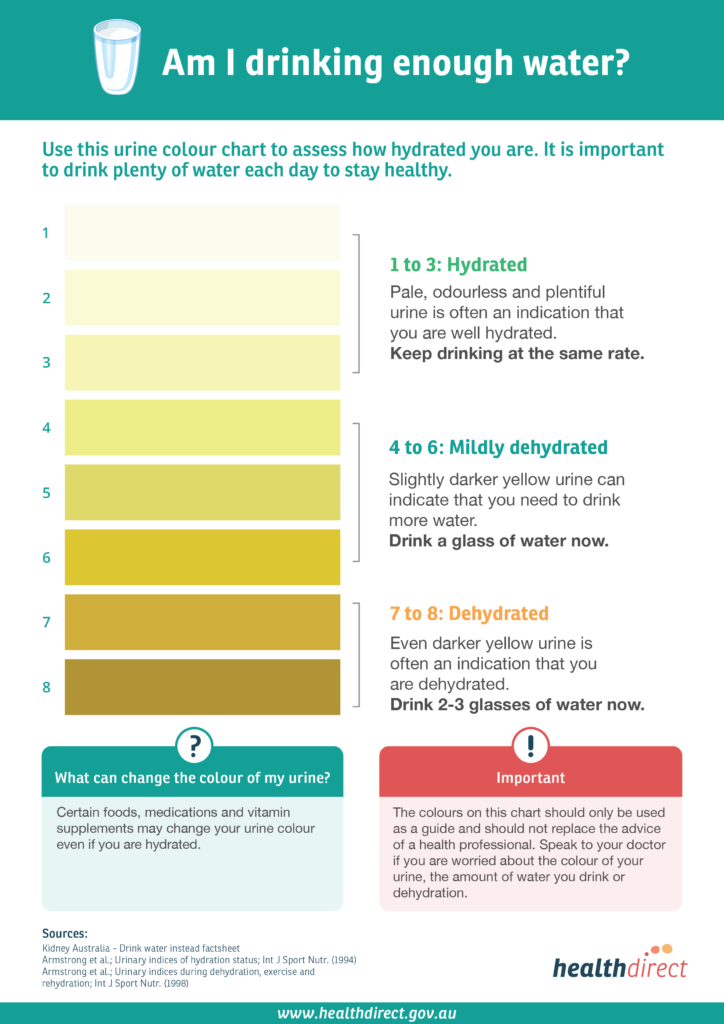
Some common causes of dehydration include excessive sweating, diarrhoea, vomiting, and increased urination (caused by some medications and medical conditions). If you know you’re losing fluids, rehydration should be a priority to avoid more serious health complications.
4 Sneaky Causes of Dehydration
If we aren’t paying attention, it’s all too easy for dehydration to sneak up on us. There are so many factors that can increase our fluid loss, and if we aren’t careful, we might only realise once we’re feeling unwell.
Here are four everyday things that might be stealthily dehydrating you:
Diet Pills & ‘Fat Burning’ Supplements
If you’re taking weight loss supplements or diet pills, be warned – many of these products are diuretics and instead of causing fat loss, simply flush water out of your system more quickly. There’s a big risk of dehydration when using these products, including many ‘slimming’ teas and herbal medicines.
The bottom line: always consult with a health practitioner before using any ‘weight loss’ supplement. It’s critical to ensure they’re safe to take and that you’re aware of any side effects.
Too Much Coffee & Tea
Keep an eye on your intake of caffeinated liquids, too – overdoing it on coffee or even green tea can dehydrate you faster. Caffeine is a diuretic, causing you to go to the bathroom more frequently and speeding up fluid loss.
Coffee, black tea, green tea, soft drinks and energy drinks are all culprits in dehydrating you. If you’re drinking anything caffeinated, make sure you’re getting enough water as well, rather than relying on caffeinated drinks for your fluids.
Some common herbal teas also have a diuretic effect, including dandelion, hibiscus and ginger.
Hot, Humid Weather
I know this one is obvious, but if you check out the news around festival season each year, you’ll discover an epidemic of heat-related illnesses. Hot weather can lead to something called ‘insensible water loss’ – basically, you’re losing fluids without realising it.
Sweltering temperatures increase sweating as the body tries to cool down itself, even if you’re not physically active. Humid, tropical climates make this even worse, as it’s harder for sweat evaporation to lower our temperature.
It’s easy to forget about staying hydrated when we’re having fun in the sun (especially if there’s day drinking involved). Heat stroke is all too common when people lose track of their water intake – so when you’re outdoors in summer, keep that water bottle handy!
Improper Exercise Hydration
You’d be surprised how many people aren’t properly hydrating for their workouts, even when they’ve been training regularly for years. Notably, you shouldn’t wait until during or after your session to drink water – pre-hydration is the key.
Dehydration can occur in just 30 minutes when exercising, so keep an eye out for symptoms. Check the colour of your urine, too – if you’re already dehydrated before you start sweating, you’re not far from feeling the effects.
Can I Stay Hydrated Without Drinking Water?
Not all your fluid needs to come from plain water, but it should be your main source of fluids. Other beverages (and foods with a high water content) still help you stay hydrated, but there are two reasons they shouldn’t be your only fluid intake.
Some drinks are diuretics, which have a dehydrating effect on the body. Diuretics include alcohol, coffee, caffeinated tea, some herbal teas, energy drinks and soft drinks. These still count towards your fluid intake but aren’t as effective as plain water.
Sugary drinks are high in calories, so sipping on sweetened drinks all day adds up! For example, a 350ml glass of apple juice is equivalent to eating 7 sugar cubes! Multiply that by eight glasses, and that’s 4720kj – about half your daily energy intake.
Adding so many liquid calories to your diet makes it difficult to maintain a healthy weight, especially when you aren’t getting any fibre or protein to fill you up. That’s why sugary drinks are a dangerous source of ‘calorie creep’ – they’re all too easy to guzzle down.
If you struggle to drink a lot of plain water, here are five tips to help you increase your fluid intake:
- Boost your hydration at mealtimes with bone broths and soups
- Snack on fruit and veg with a high water content (like melon, pineapple, celery and cucumber)
- Add a healthy smoothie to your daily meal plan
- Flavour your water with fruit slices or mint to keep it interesting
- Try sparkling water – you can add carbonation to tap water with a SodaStream
These shouldn’t be a substitute for drinking water, but they can help increase your hydration levels. Research shows that, on average, about 30% of our fluid intake comes from food – but that still leaves the remaining 70% to top up.
If you can find a way to enjoy (or even tolerate) water, you’ll be doing your body a lifelong favour!
Next Steps
Looking to build healthier habits into your daily routine? Forget the expensive supplements and health foods – if you’re not already drinking enough water, that should be priority number one on your list.
If you’re eager to increase your fluid intake but are struggling to hit your goal, here are a few handy tips:
- Get a big glass of water with every meal and snack (this helps avoid overeating, too)
- Carry a reusable water bottle with you throughout the day
- Set regular reminders on your phone or work computer
- Track your water intake using your fitness tracker or an app
- Start your morning with a glass of water (a great energy booster!)
- Team up with a workmate and keep each other accountable
Keen to learn more about healthy hydration? Go ahead and check out these articles:
- 6 Sugary Drinks With Hidden Calories (Plus Healthy Swaps)
- Hydration & Exercise: How to Nail It for Maximum Performance
- Smoothie Summer: 3 Quenching Recipes To Try In The Heat
- Is Gatorade Really Good For You?
The post How Much Water Should I Really Be Drinking? appeared first on Amelia Phillips.